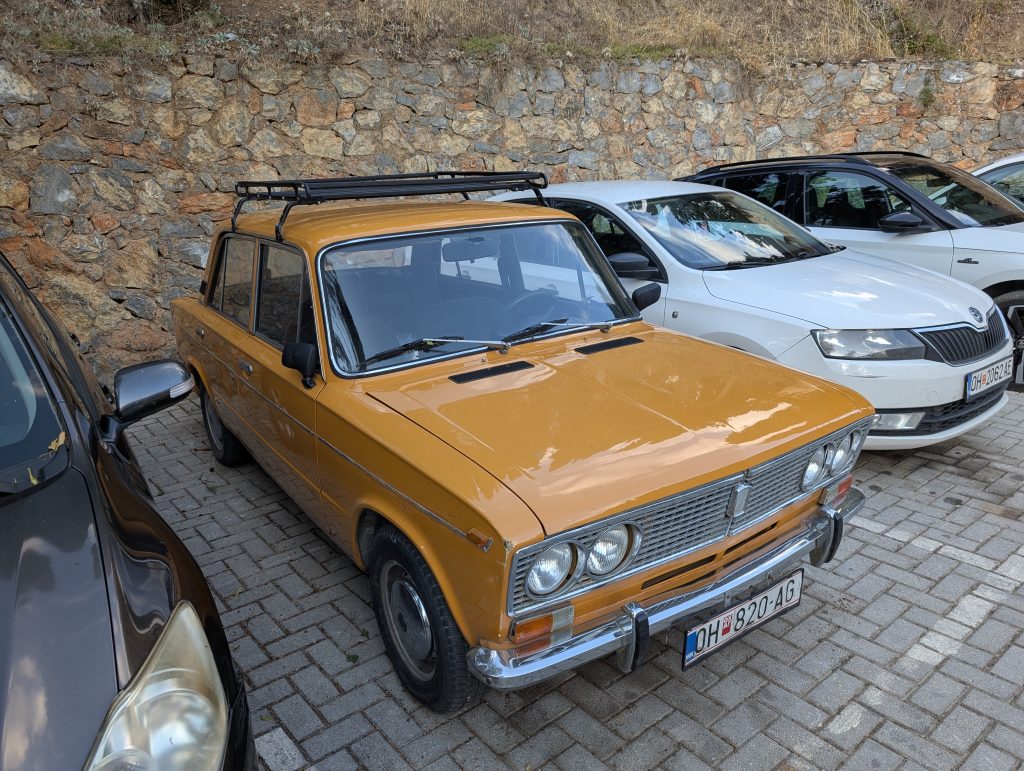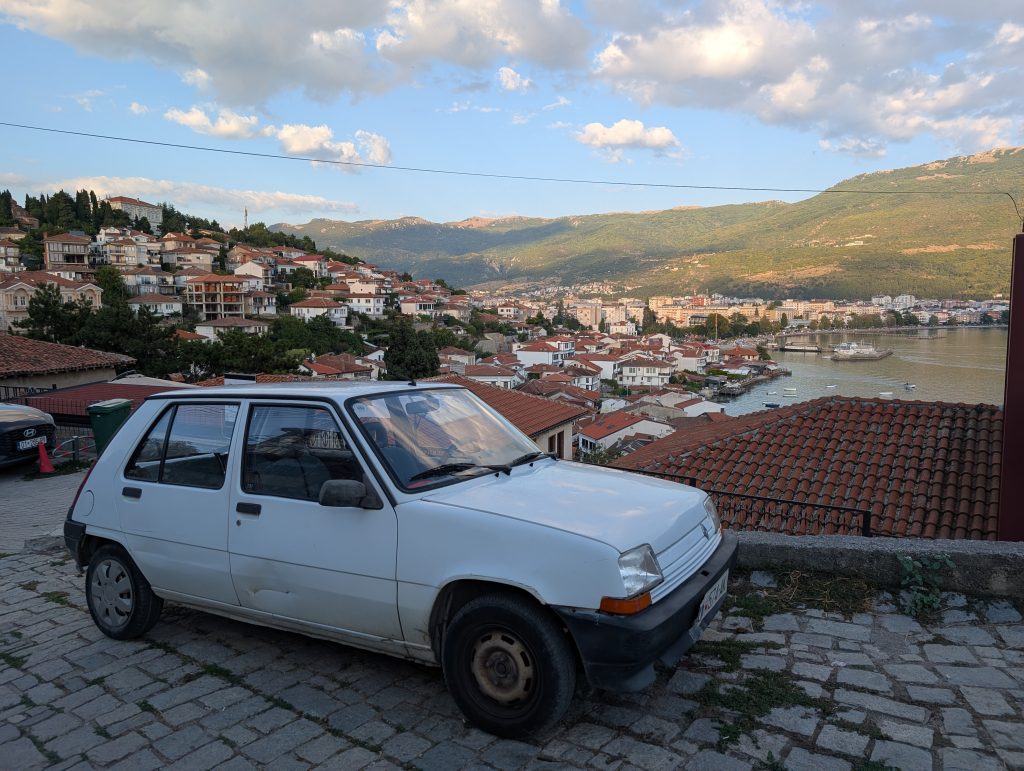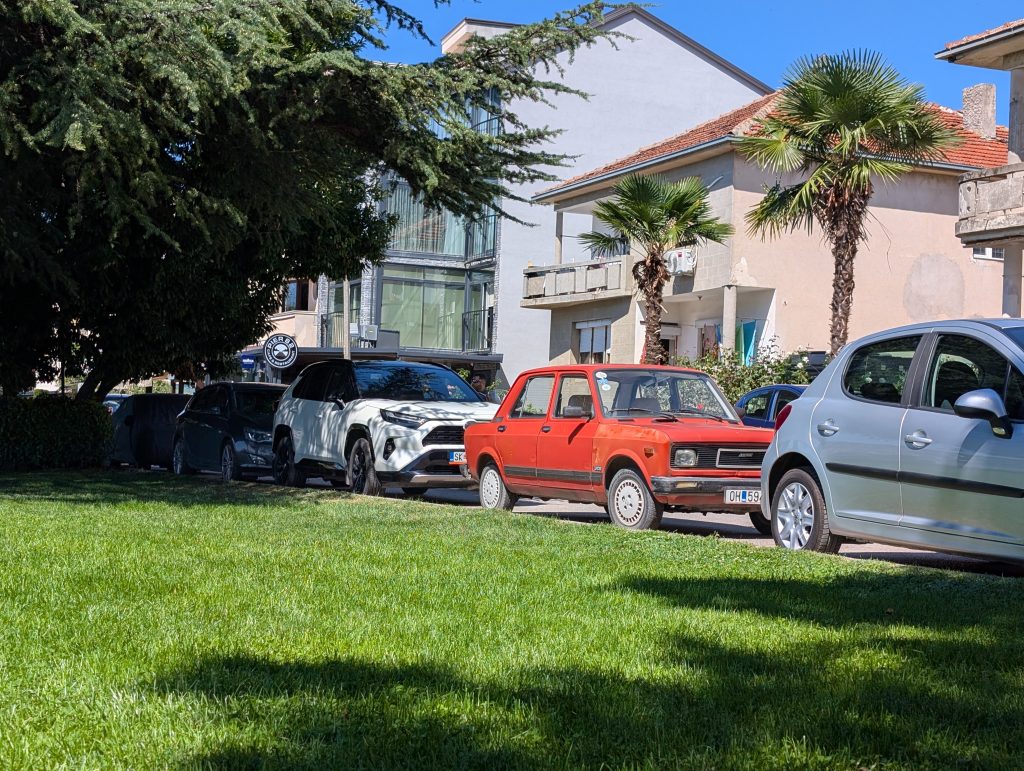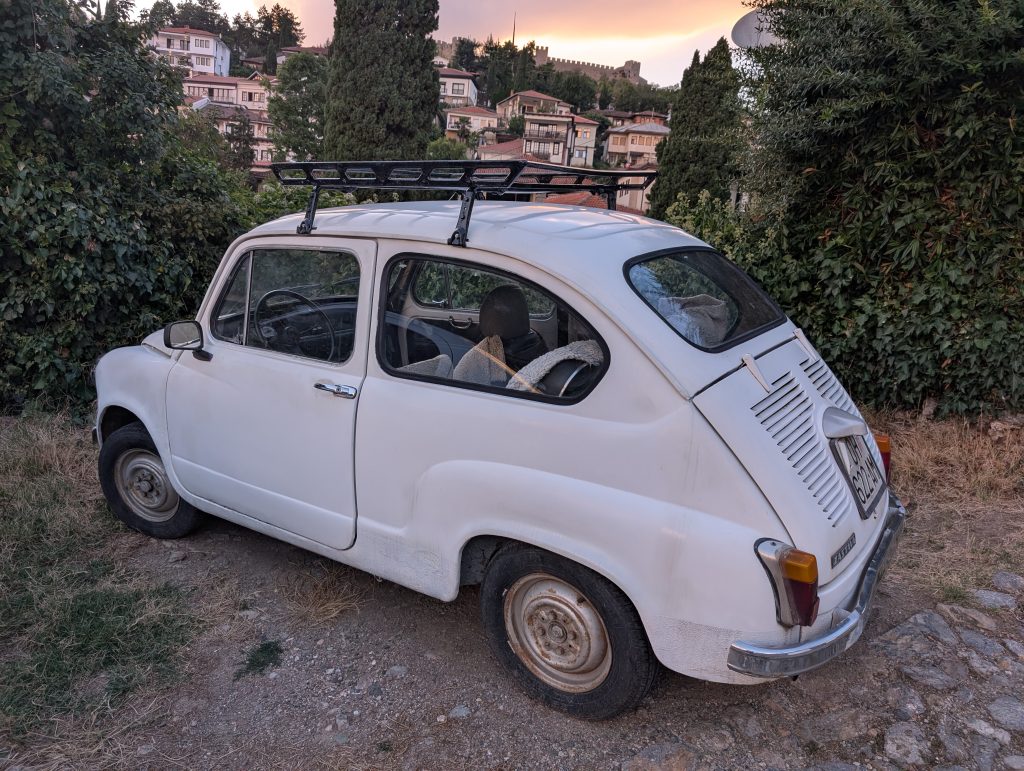I’d read great things about Lake Ohrid on the blogs of other full-time travelers, so it was a no-brainer for us to stop and spend a few days there as we made our way to Albania from Bulgaria. It definitely lived up to my high expectations. The lake itself is huge and beautiful and the town of Ohrid has far more history than I had imagined. In fact, Ohrid is one of only 40 UNESCO World Heritage sites with a dual designation of both cultural significance and natural significance.
Our four days in Ohrid were just the right amount of time to see and learn all we wanted to about this area.
Arrival and Impressions
We took a 10 a.m. bus from Skopje that was supposed to take just under four hours, but we arrived 1:15, about a half hour ahead of schedule. The company we used, Galeb, was the highest review and used a large-size bus that was about half-full. Before heading to our Airbnb we went ahead and purchased our bus tickets to Tirana at the station. There were only two times to choose from for the three-hour ride – 8 a.m. or 2 p.m. – so we chose the 8 a.m.
We found a taxi outside the bus station to take us to the old town. The quoted price was 400 denar (about $7.50), which may have been a little high for a 2 kilometer ride, but typical for a tourist town and worth it to us. Our Ohrid Airbnb host met us at a pizza restaurant next to the apartment and showed us the place up one flight of stairs (review below). It was a little dated but well worth it for the views. When I opened the blinds in the bedroom and saw the view from the balcony, I actually laughed, it was such a charming view of the lake. When researching Airbnbs, Chad and I had actually debated whether it was worth choosing a place with a lake view because we have a great one at home, but it was definitely worth it and we got a lot of enjoyment from the little balcony.
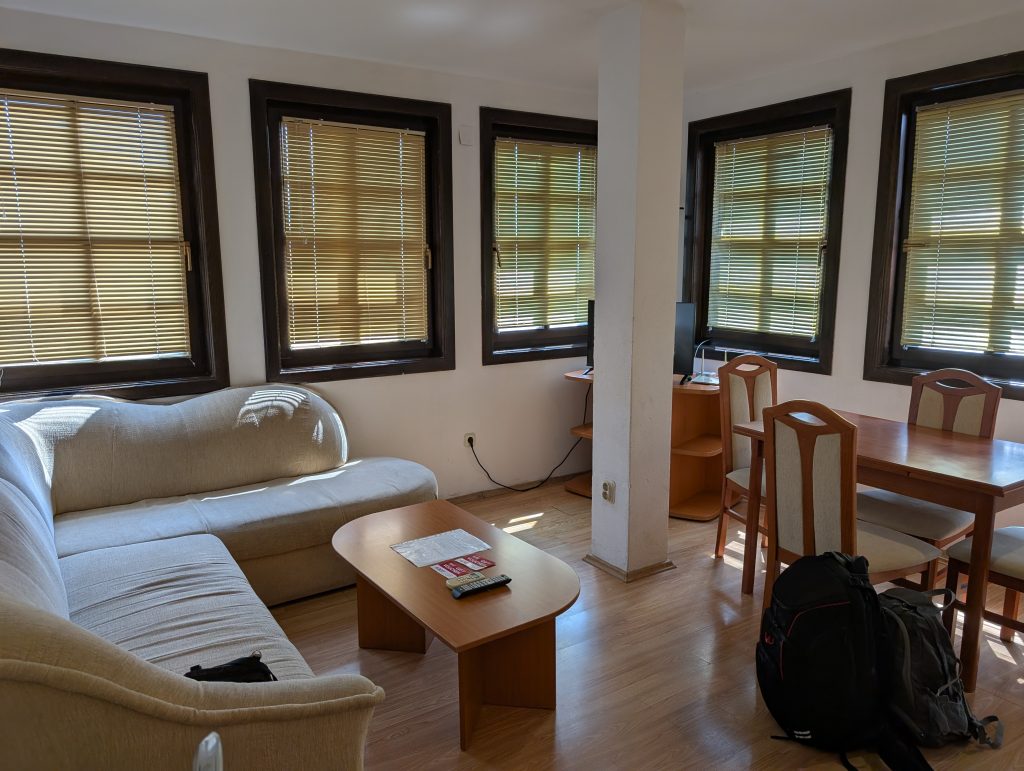
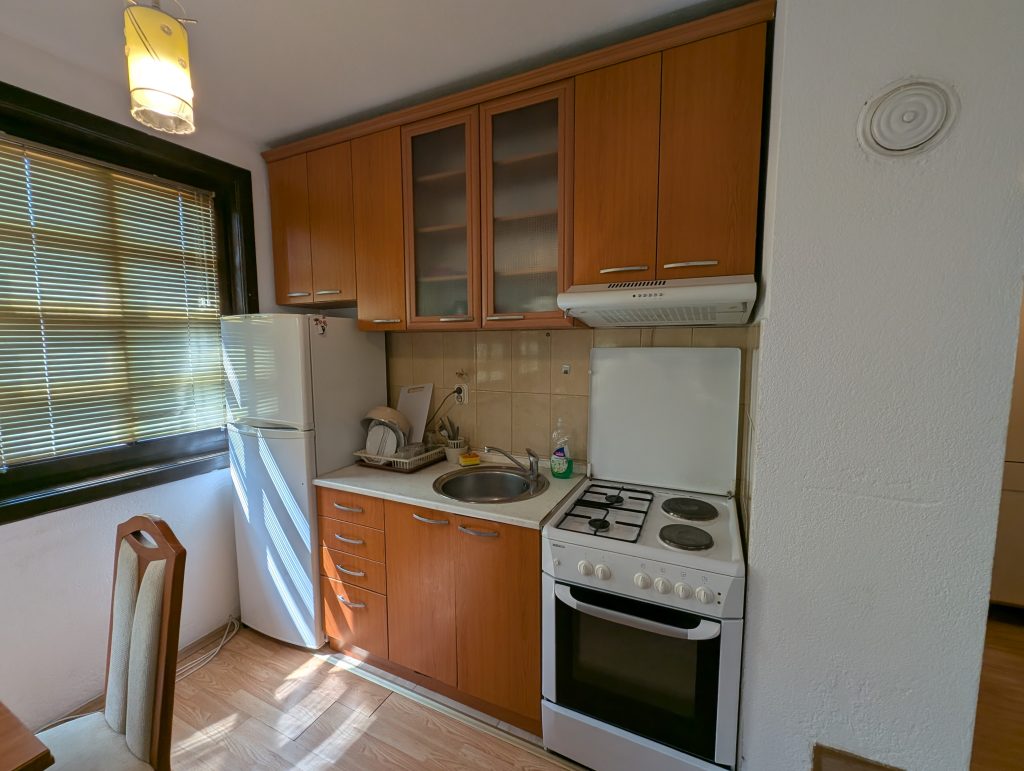
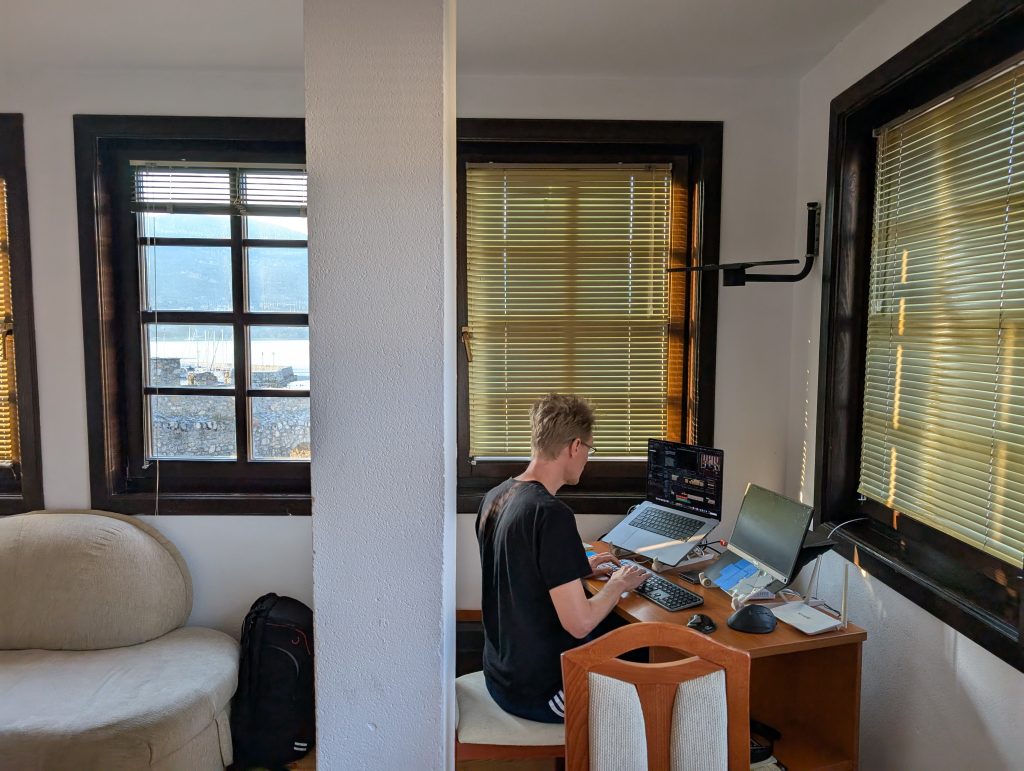
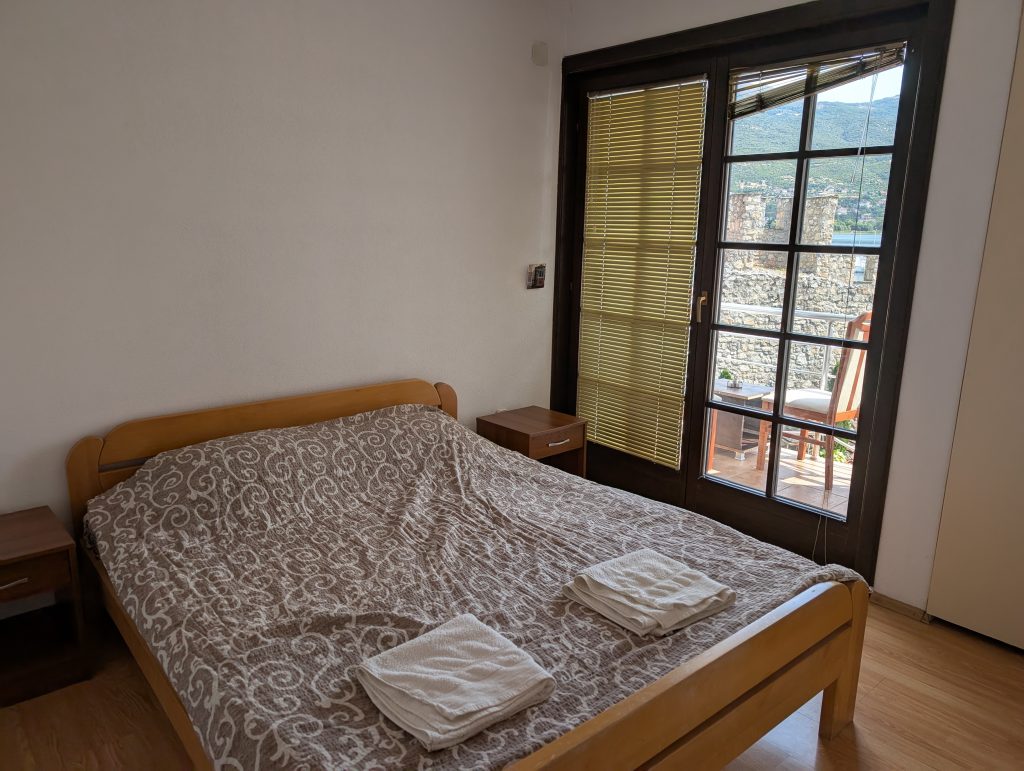
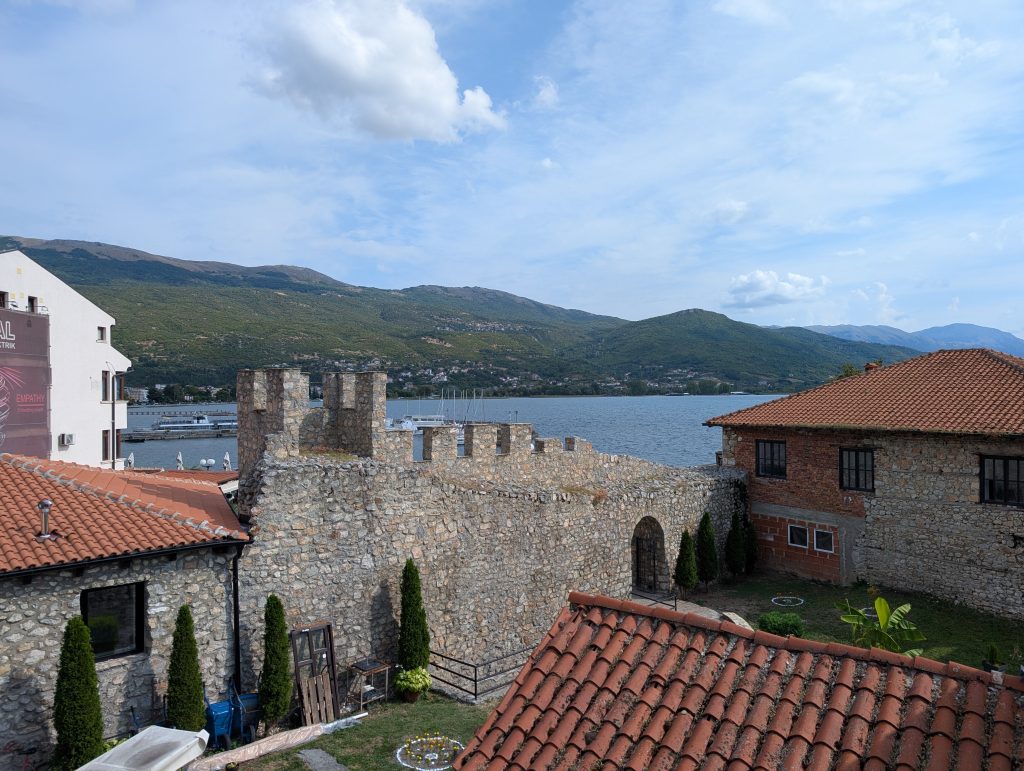
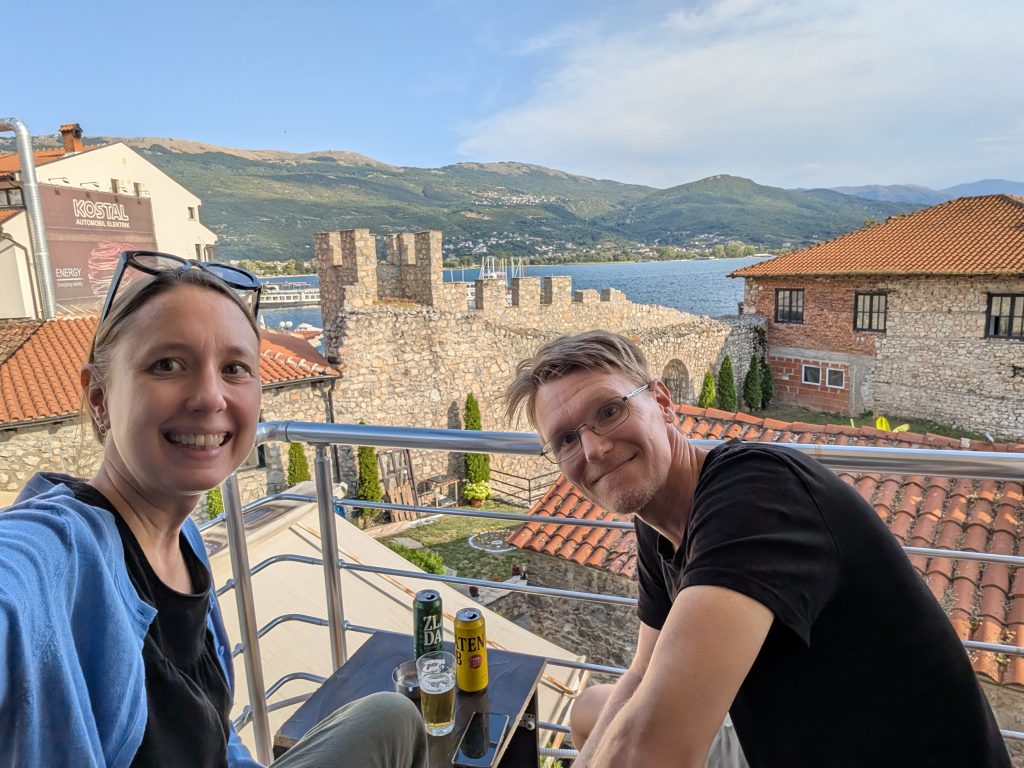
Even though it was a fairly easy travel day, they’re always tiring so we just picked up a few groceries from the Tinex Supermarket 250 meters away and made a simple dinner in (vegetarian stirfry). It was a slight challenge in the dated kitchen but turned out pretty good.
The next day we had a workday, but broke it up with a very nice walk along the lake, stopping into a Macedonian restaurant Chad researched near our place called Viva Ksantika kaj Tanja to make a reservation for that evening.
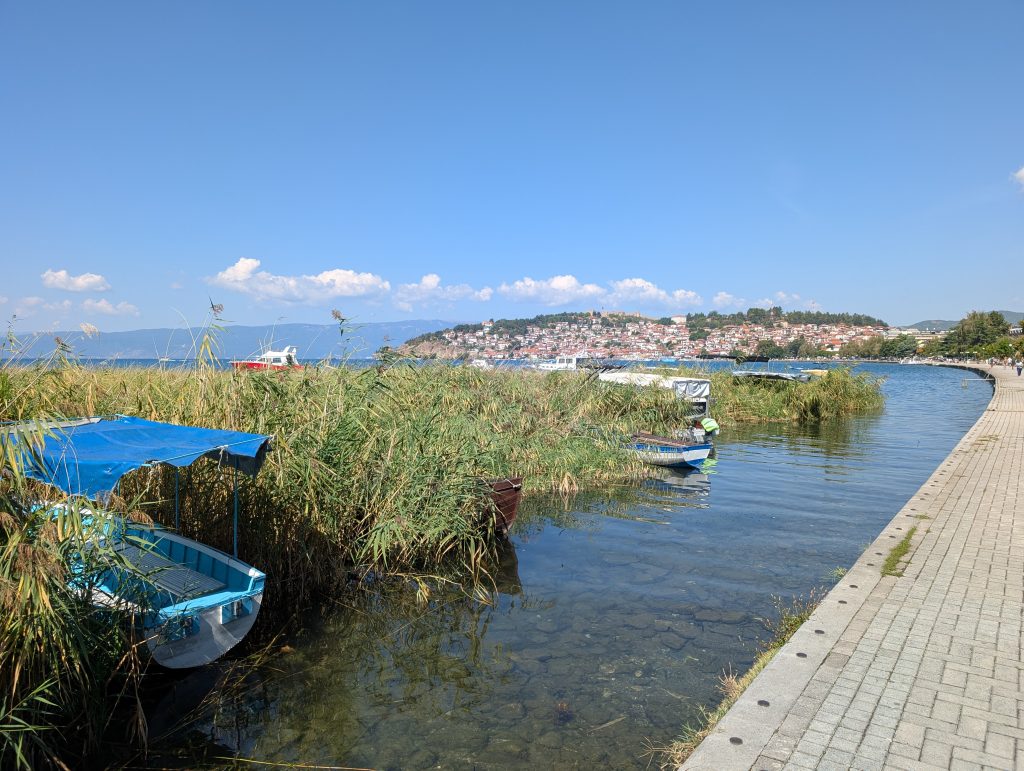
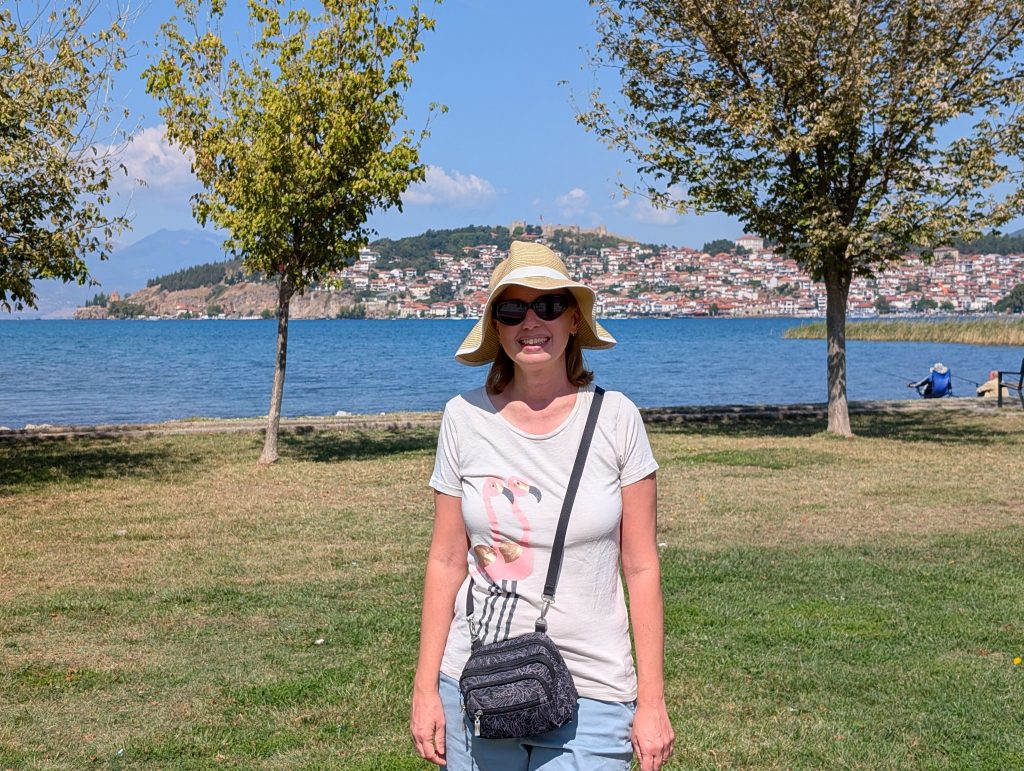
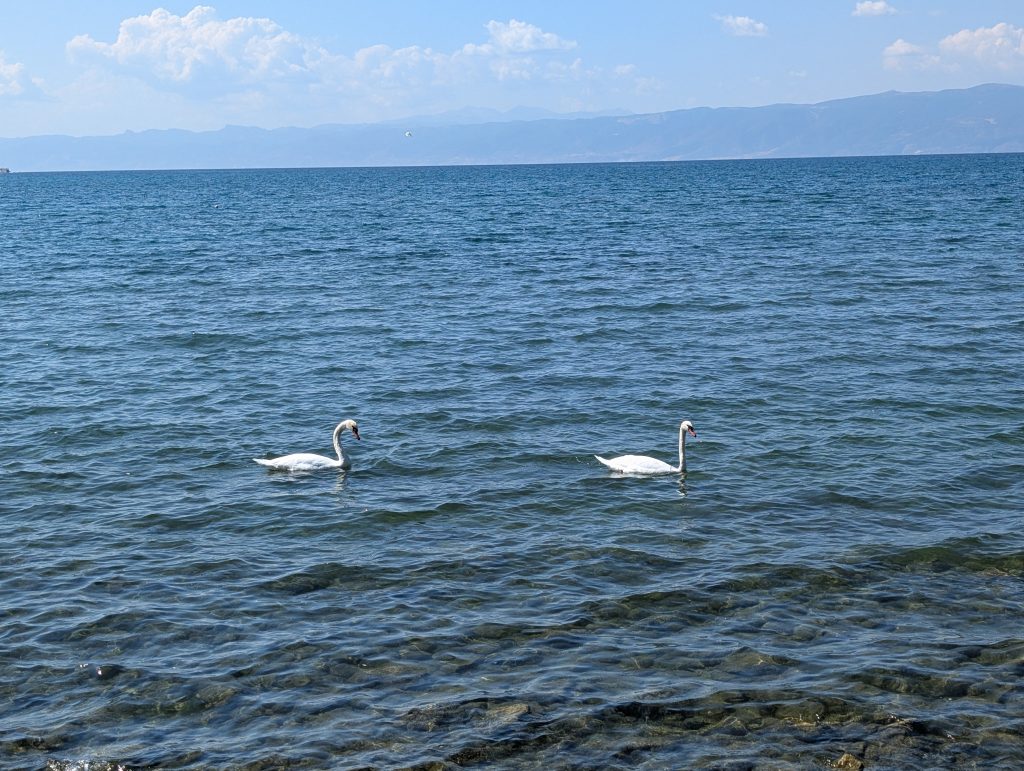
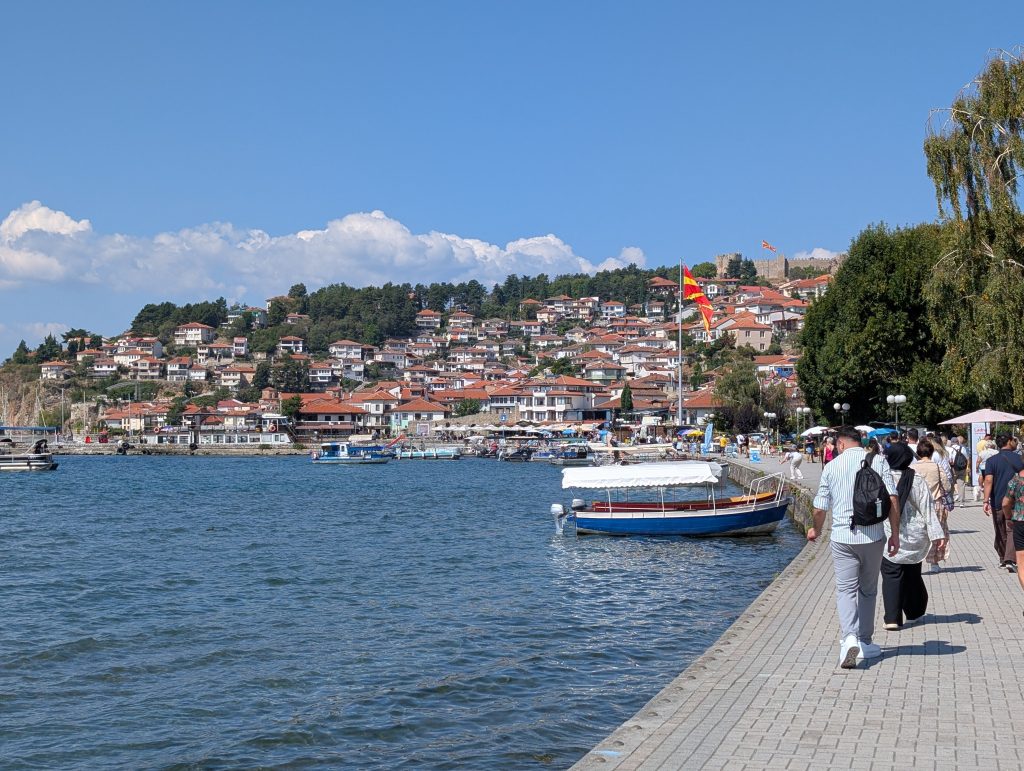
We preceded our reservation with an evening walk along the lake and out to the Church of Saint Jovan the Theologian at Kaneo, the most picturesque of Ohrid’s many historic churches, as it sits on a point overlooking the lake. We took some nice photos and then stopped for a drink at a lakeside bar. The restaurant was a great choice and we loved our meal of mixed salad, tavče gravče (the bean dish we’d tried in Skopje), turli tava (a vegetable stew that is another national dish), and traditional bread. We also got some baklava for dessert.
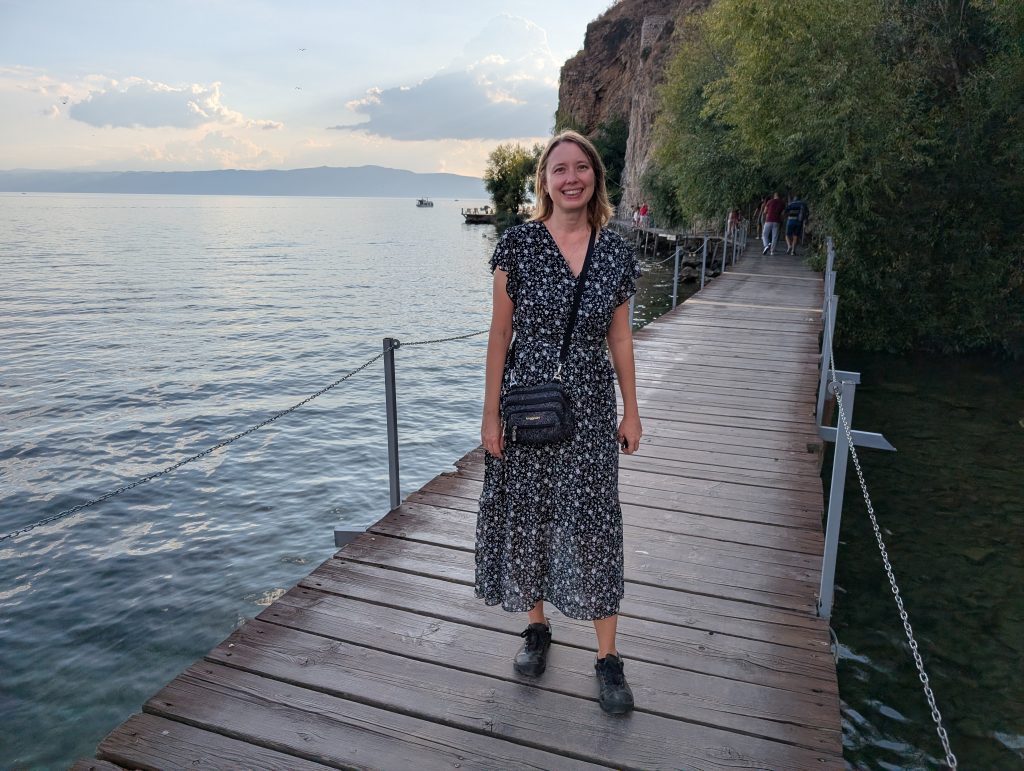
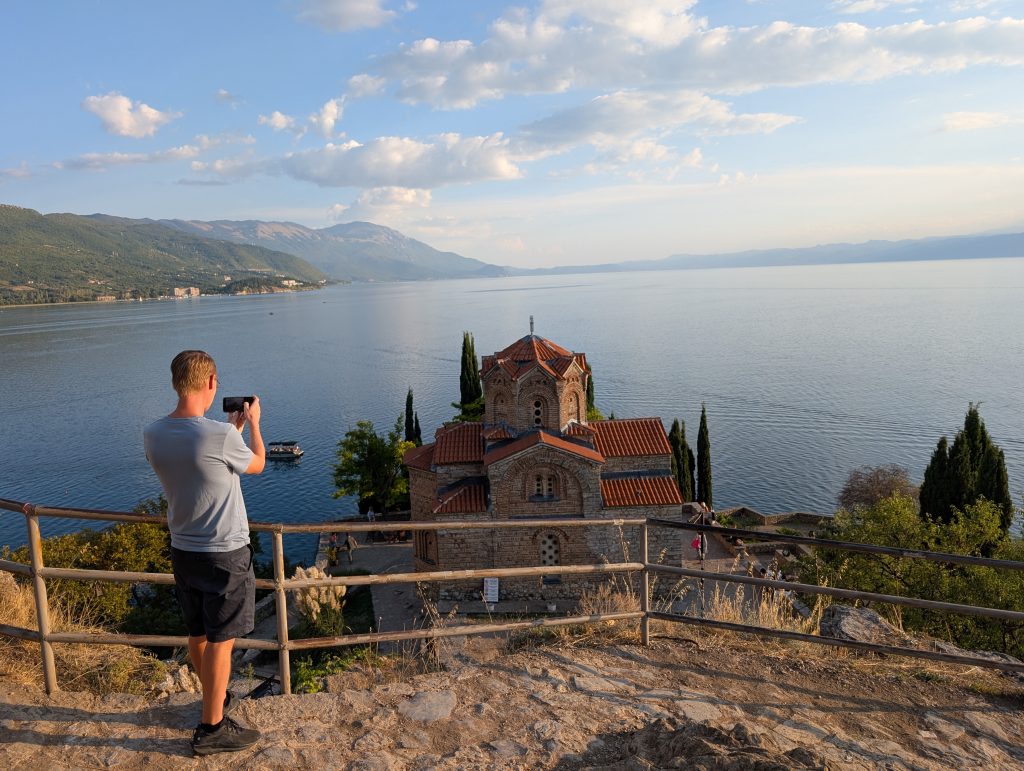
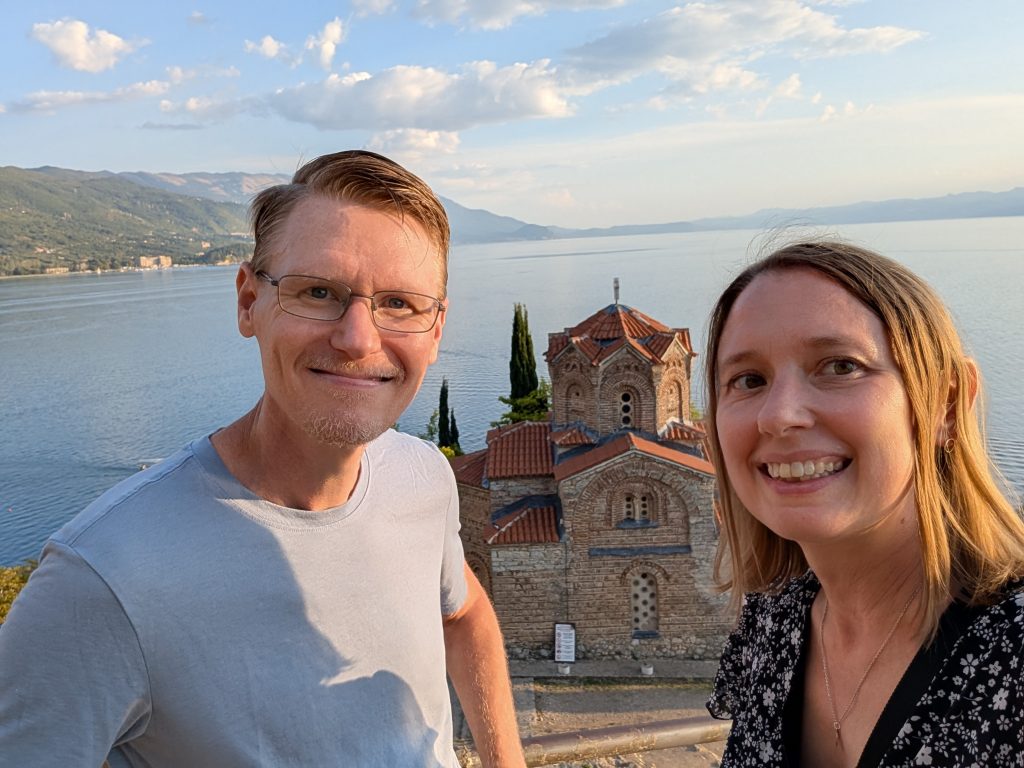
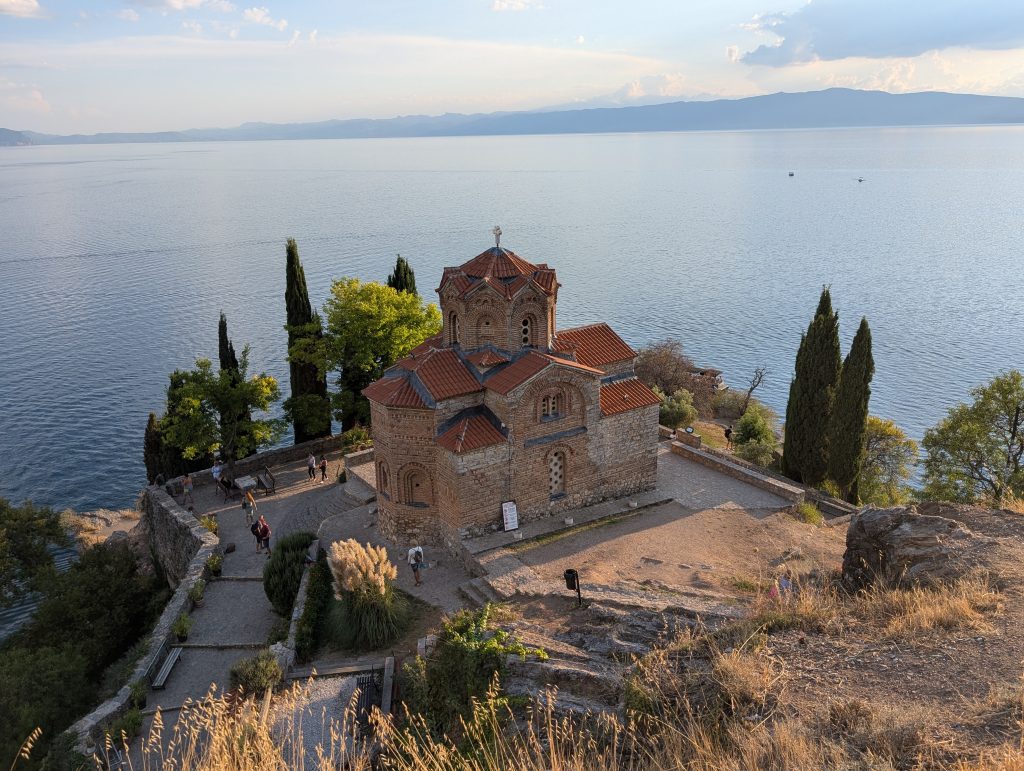
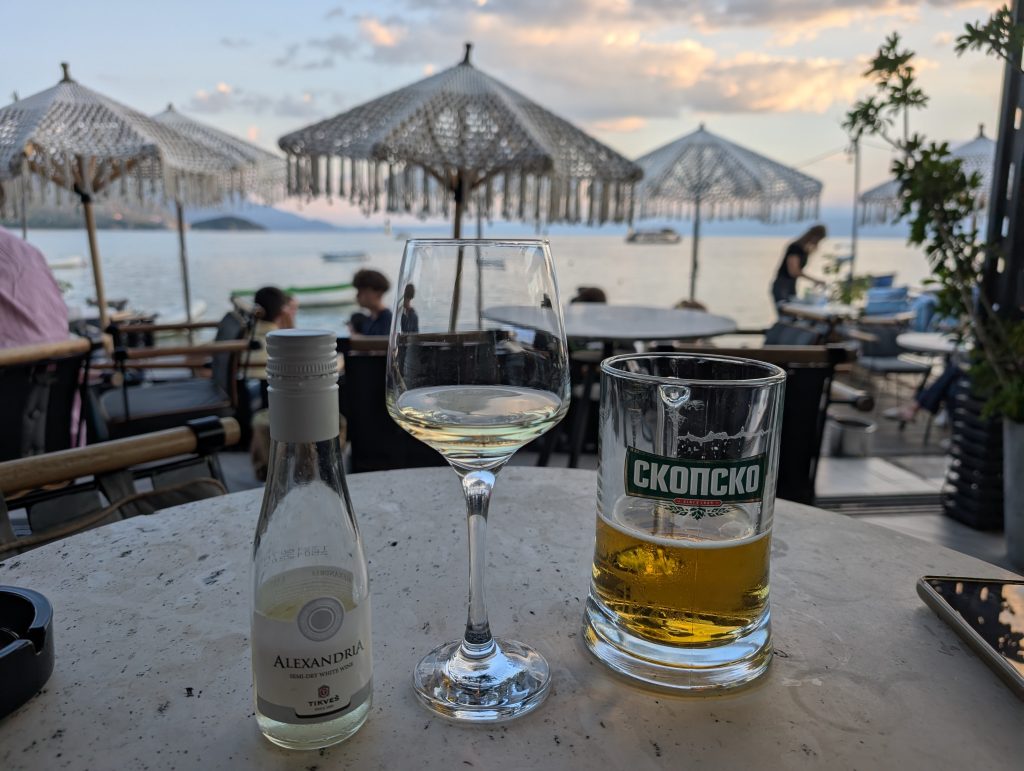
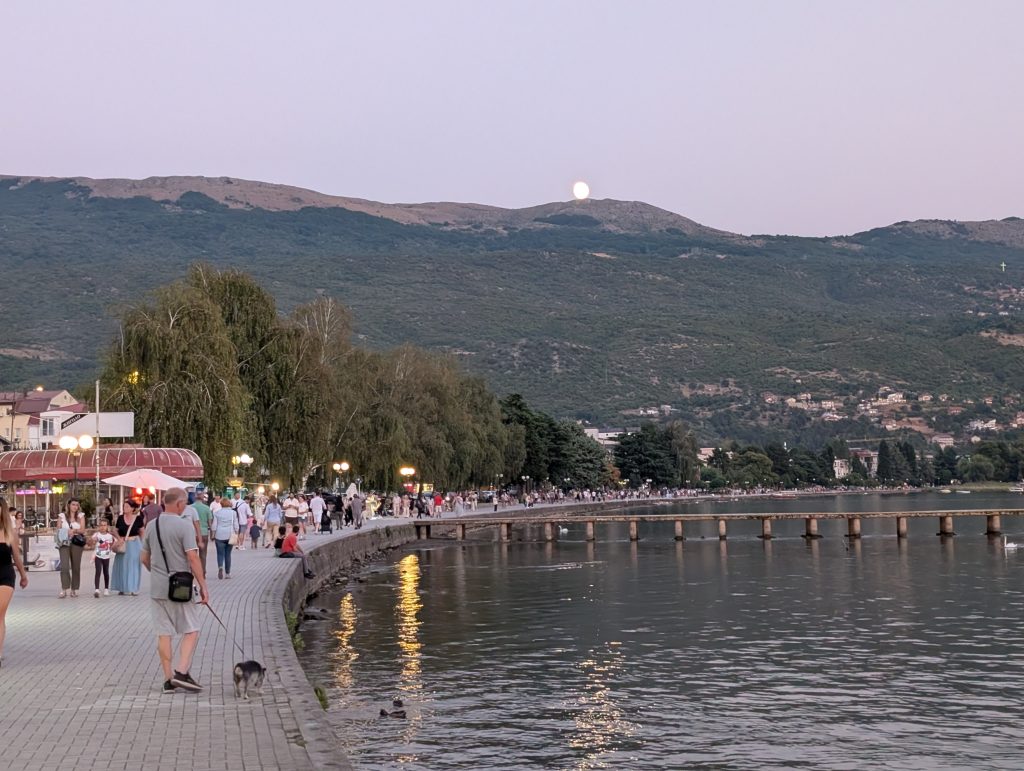
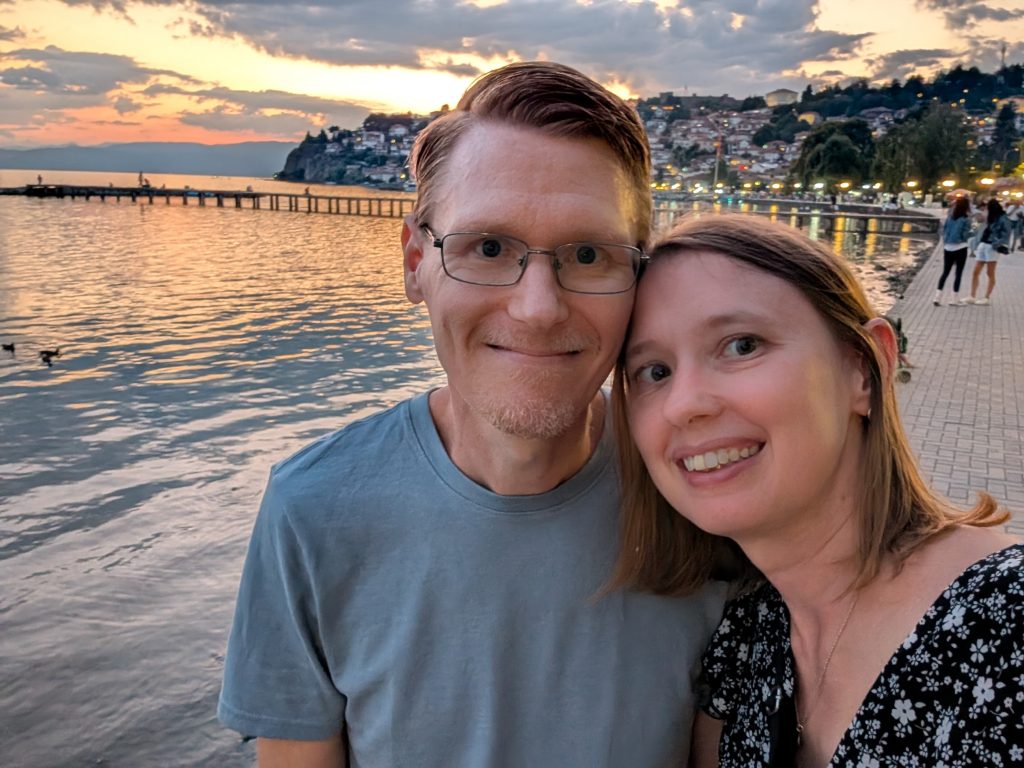
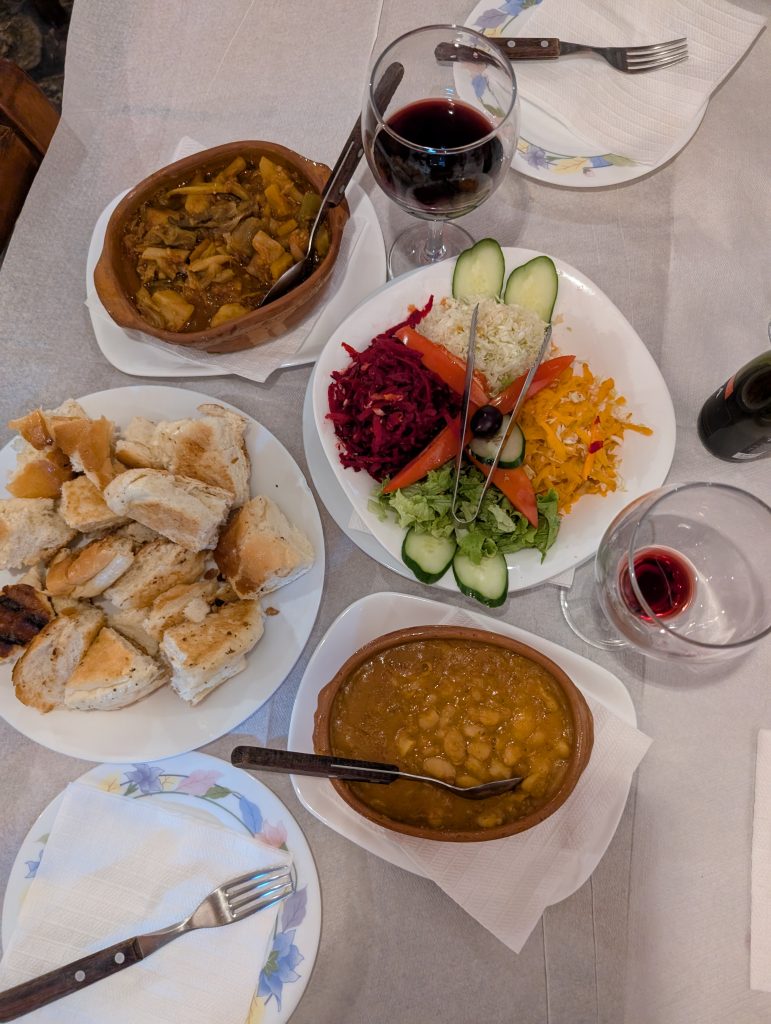
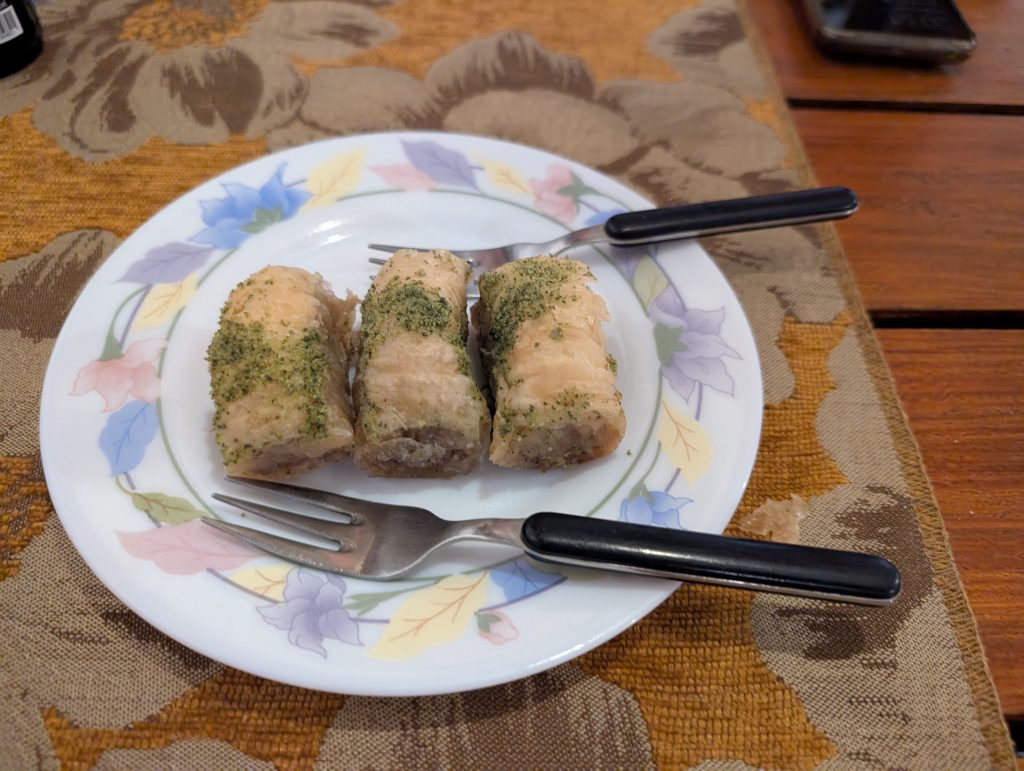
Saturday “Church Crawl”
The next day was Saturday and Chad put together a little morning tour from us with the help of ChatGPT to visit several of Ohrid’s historic churches. Ohrid was a very important religious center from the 9th through 11th centuries and is sometimes called “the Jerusalem of the Balkans.” At one time it supposedly had 365 churches, one for each day of the year. The Ohrid Literary School, established in the 9th century, translated religious texts into Cyrillic and was essential to the spread of Orthodox Christianity. We visited five sites on our tour – three churches, a fort, and a gallery of religious icons. Each had a fee of 150 denar per person (about $3). Most accepted credit cards but a couple were cash only.
We started our tour at the Church of Hagia Sophia, which, like the version in Istanbul, was converted into a mosque during the Ottoman Empire. That meant the beautiful frescoes on the walls were plastered over, but a restoration effort is working to restore them. Learning about this process was especially interesting. Since we arrived just as the church opened at 9 a.m., we had the interior to ourselves, though there was a large tour group outside.
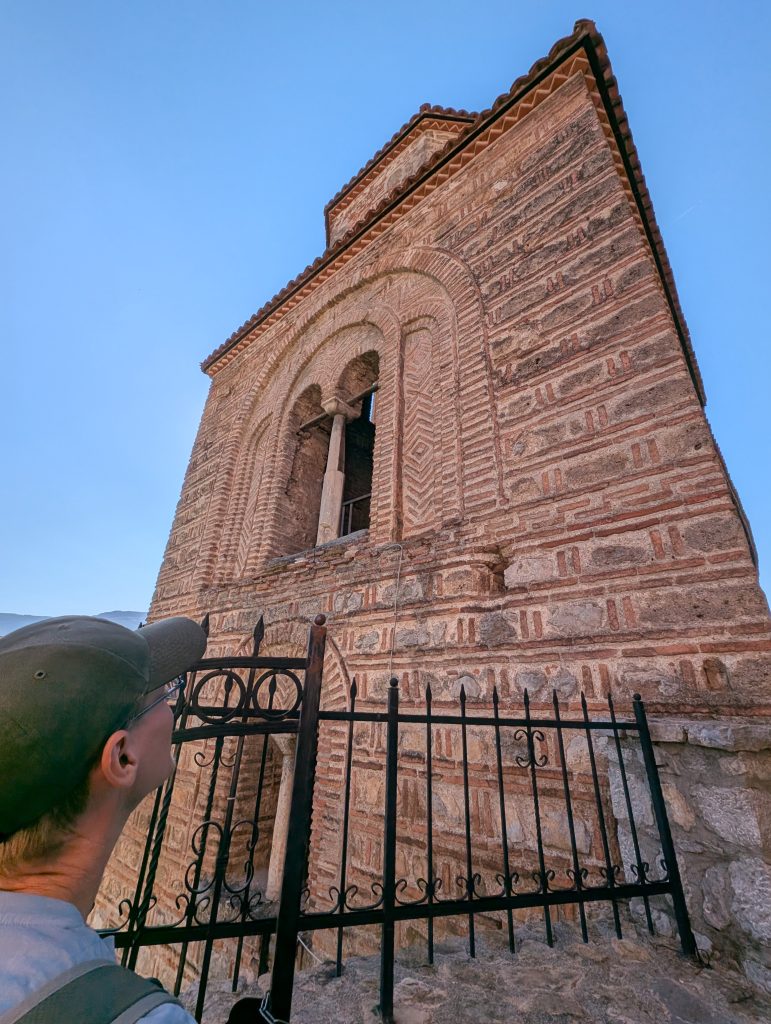
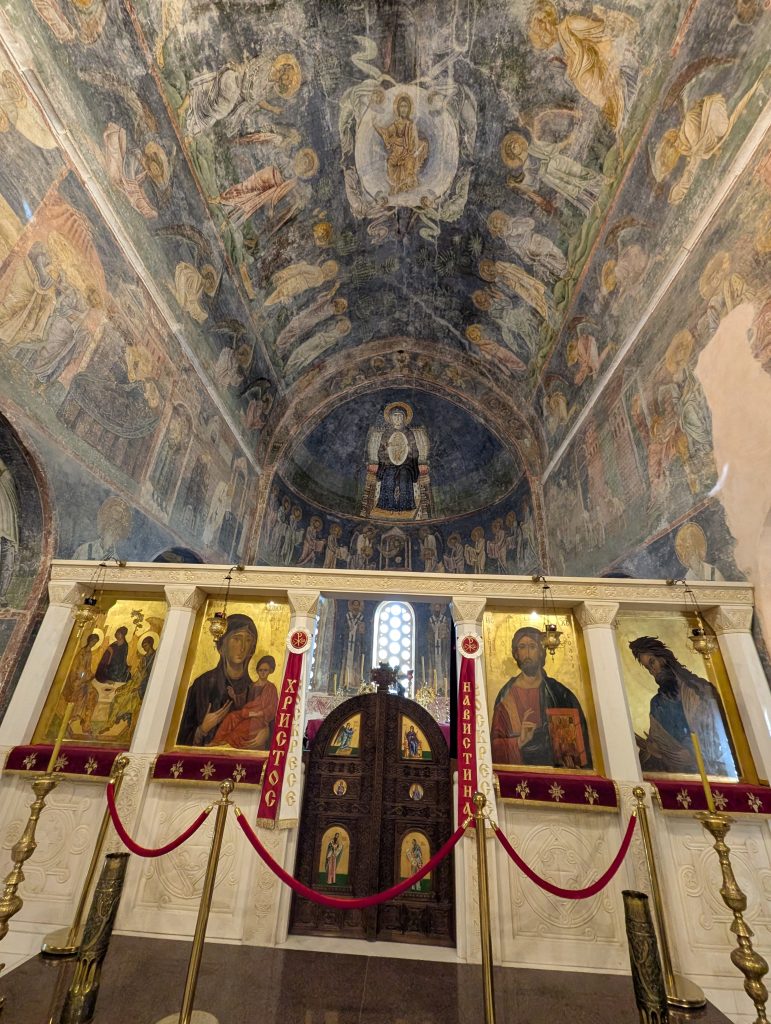
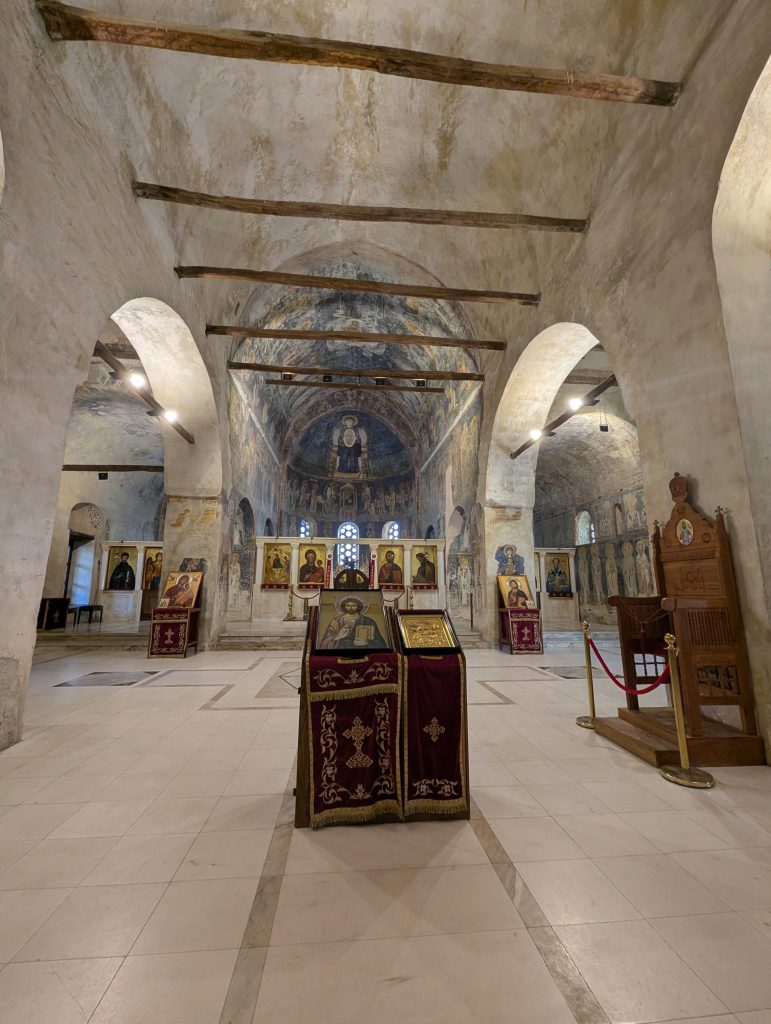
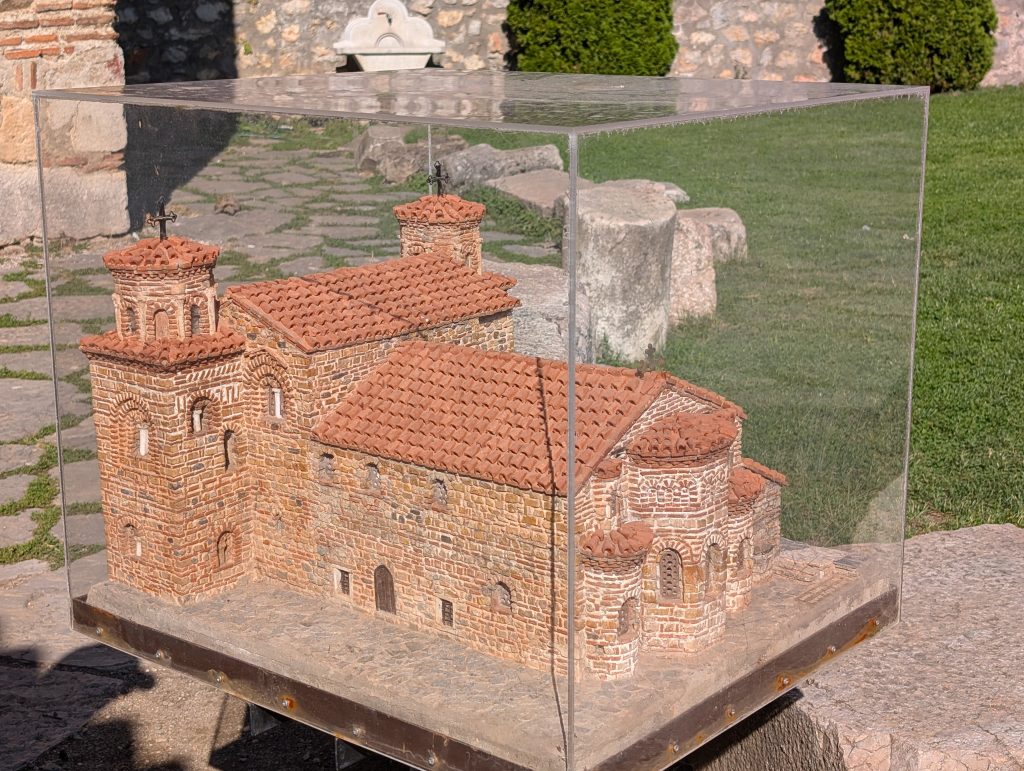
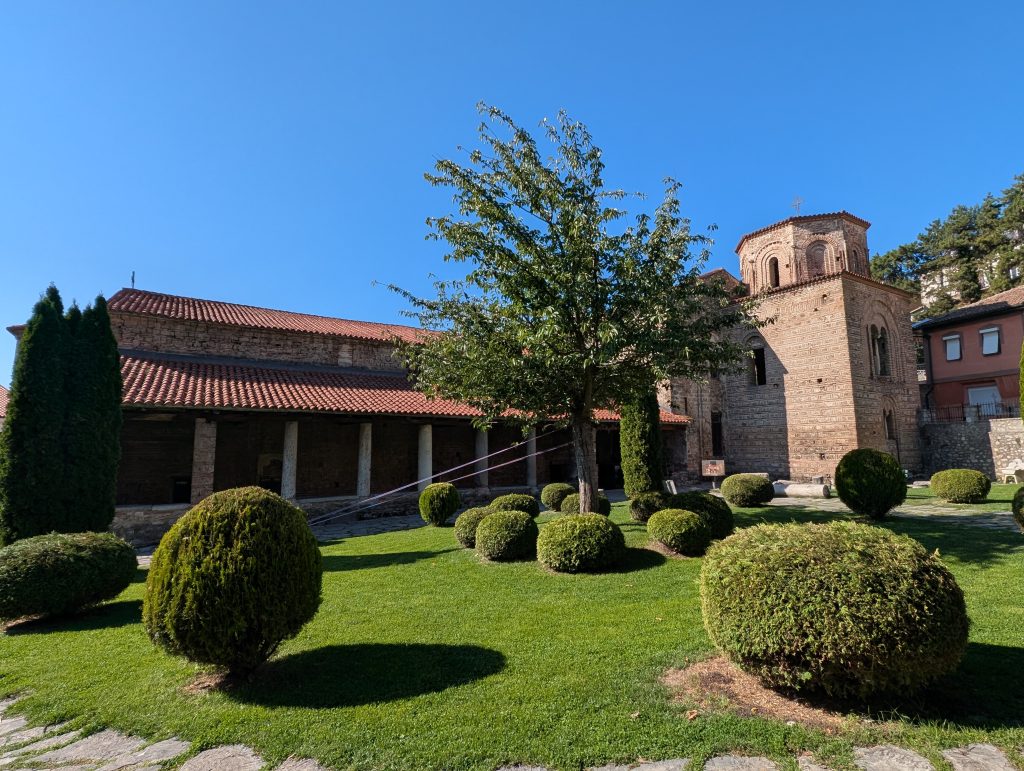
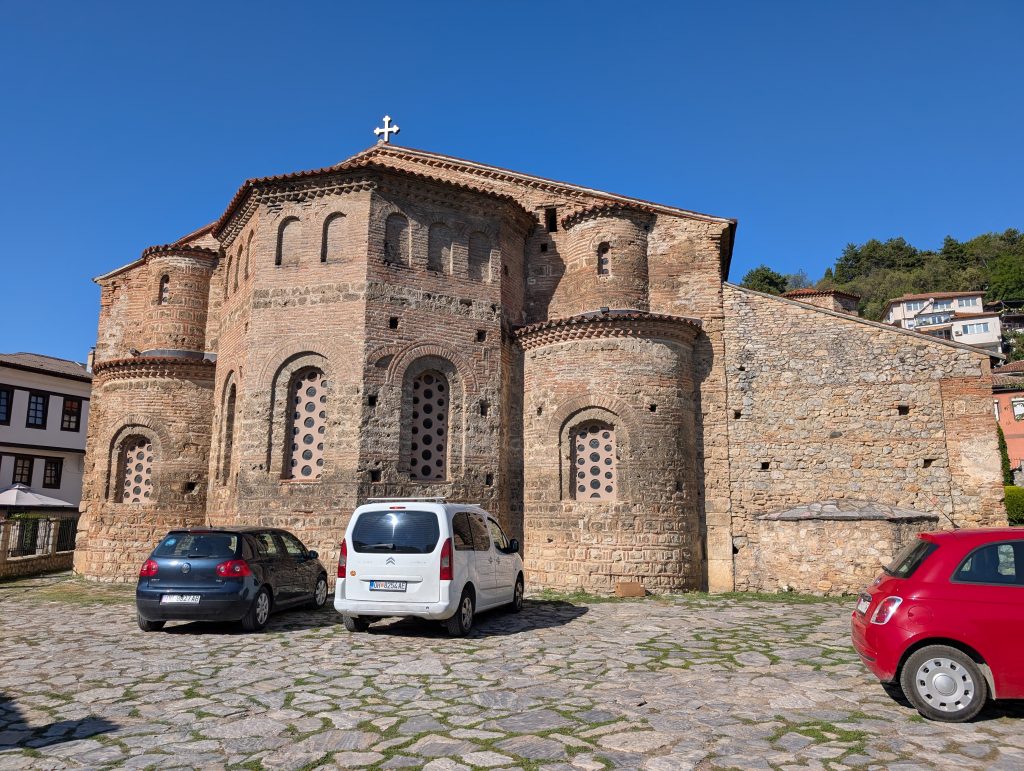
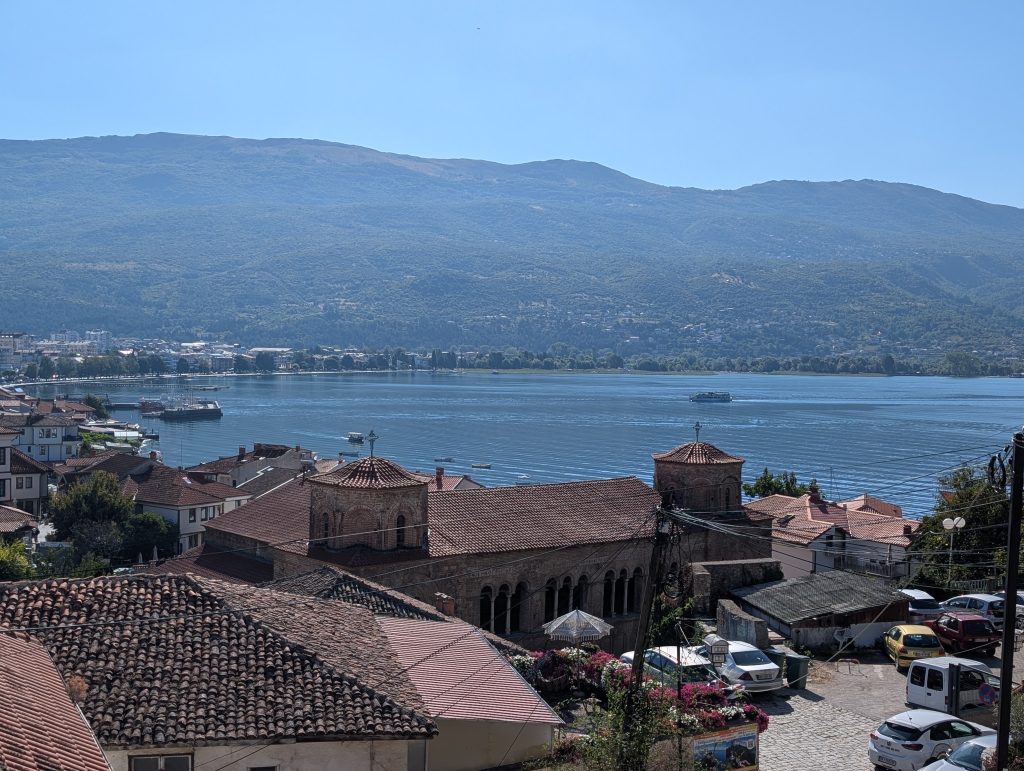
From there we went up Ohrid’s steep hills to the Plaoshnik Archaeological park and Church of St. Clement of Ohrid. This church was interesting because it was rebuilt rather than restored, with fresh bricks and new frescoes painted on the inside. Unfortunately they didn’t allow interior photography, but it provided a great sense of what the frescoes at all the churches would have looked like when new. The exterior also showed off the interesting patterns in the brickwork that were traditionally used.
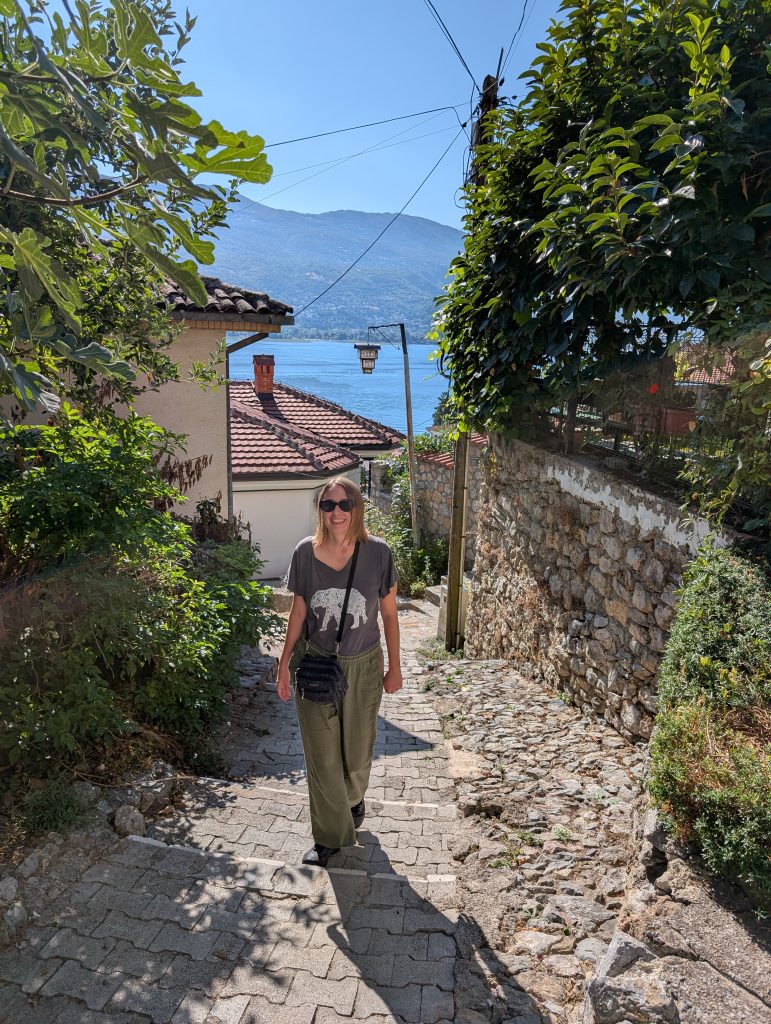
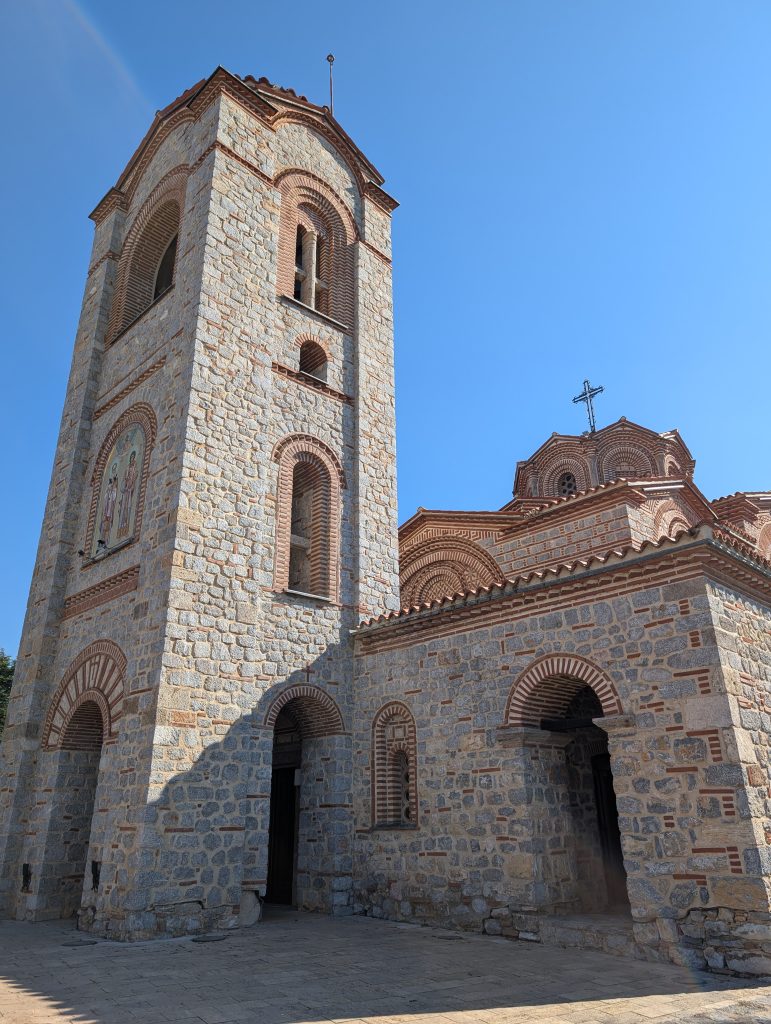
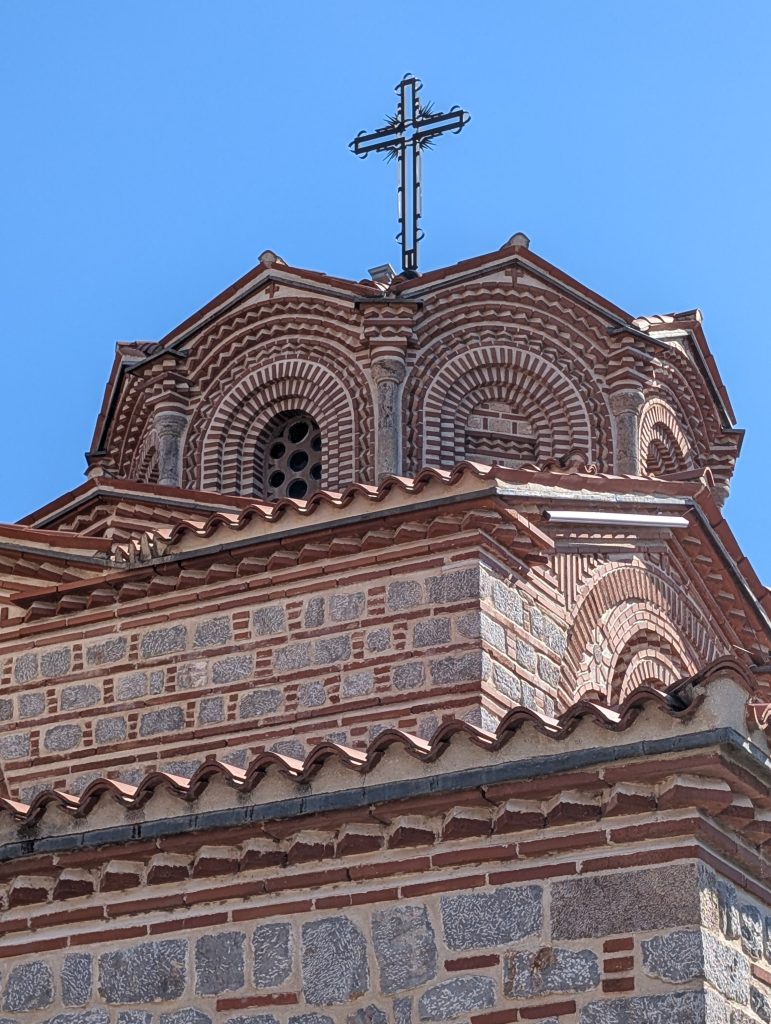
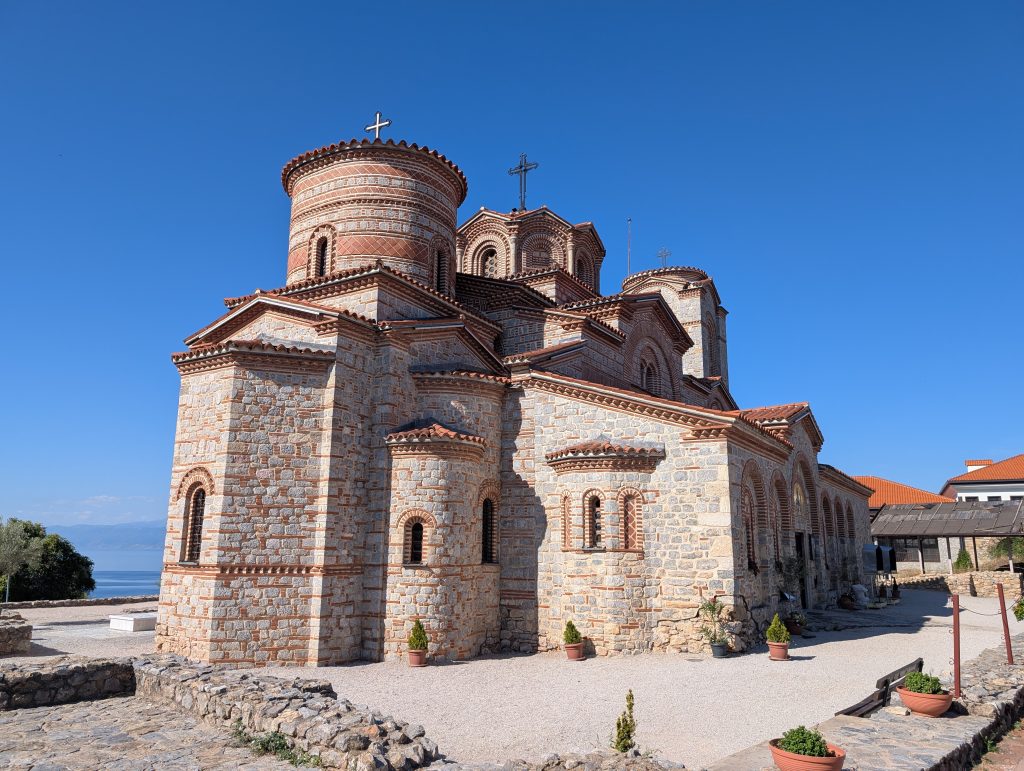
The archeological site of Roman ruins was also interesting to see, though not a lot of information was provided.
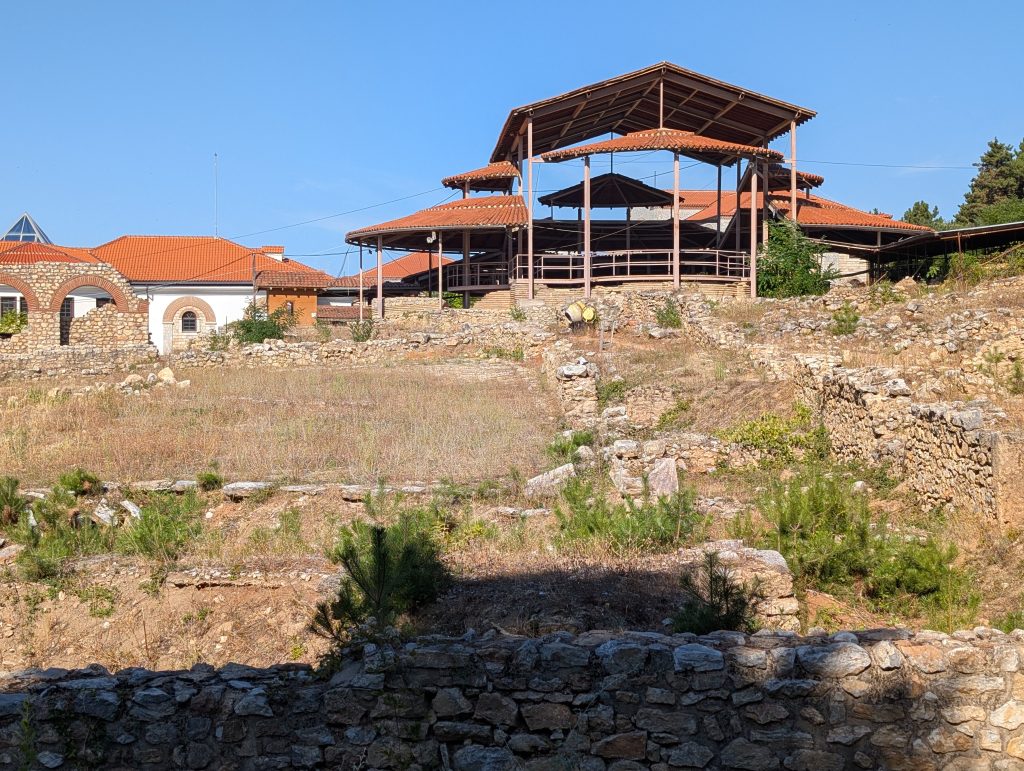
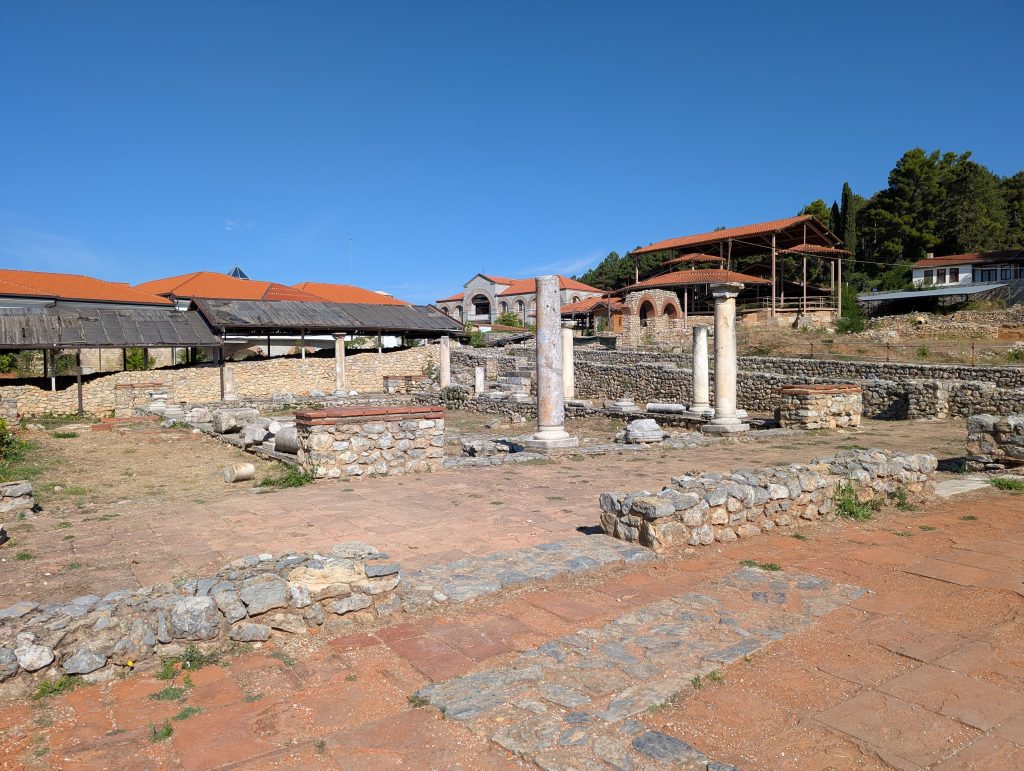
Next we went to Tsar Samuel’s Fortress from the 10th century, though it had been periodically destroyed and rebuilt. We didn’t bother learning much of the fortresses history but enjoyed walking along its walls and the great views of Ohrid and the lake.
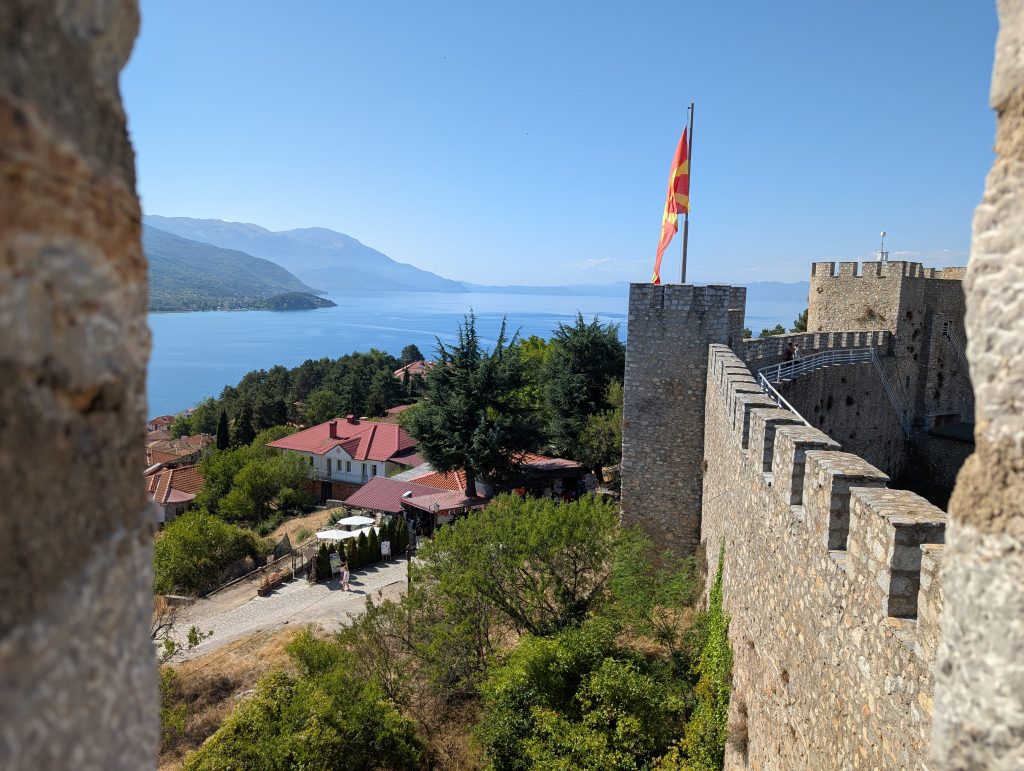
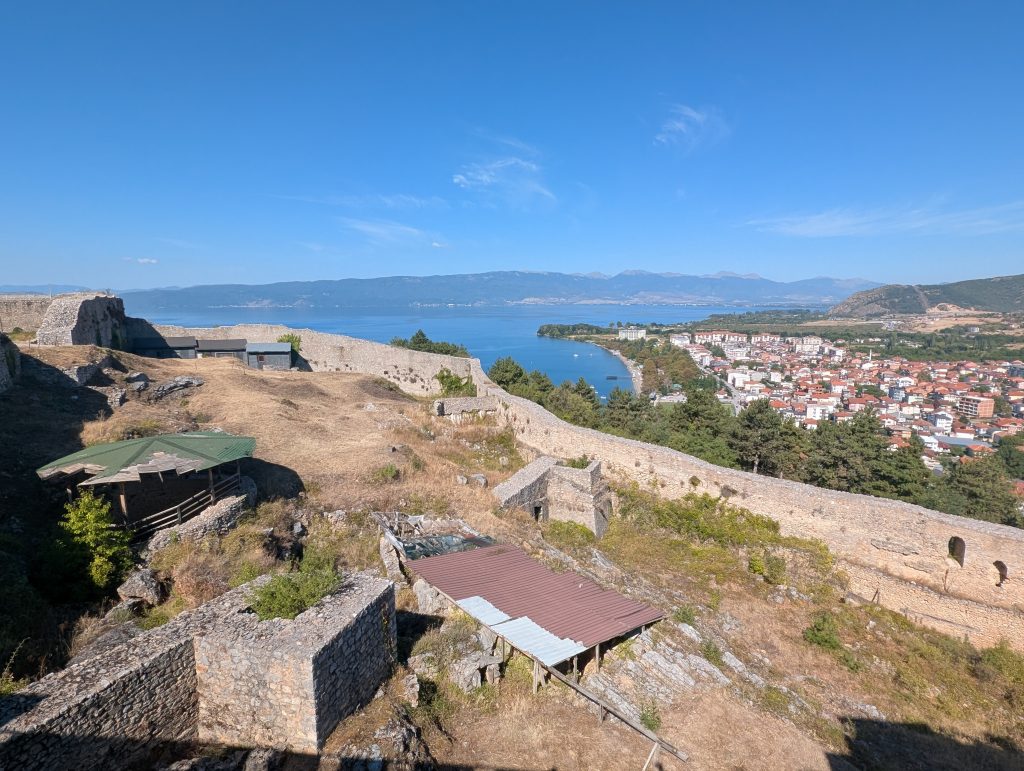
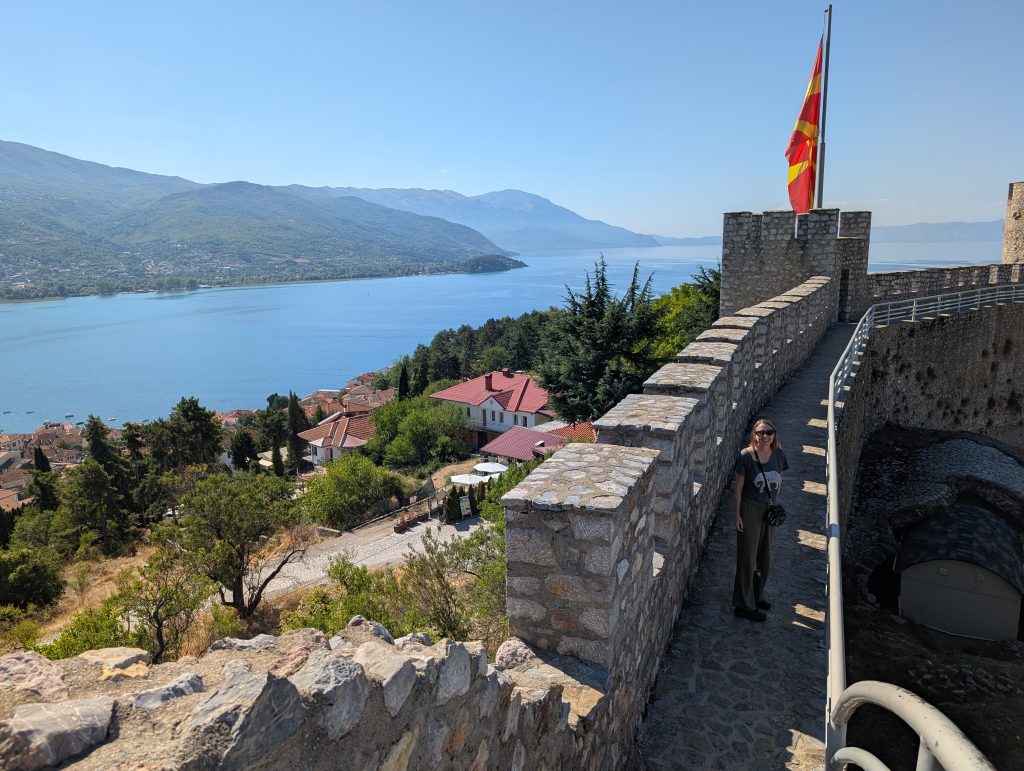
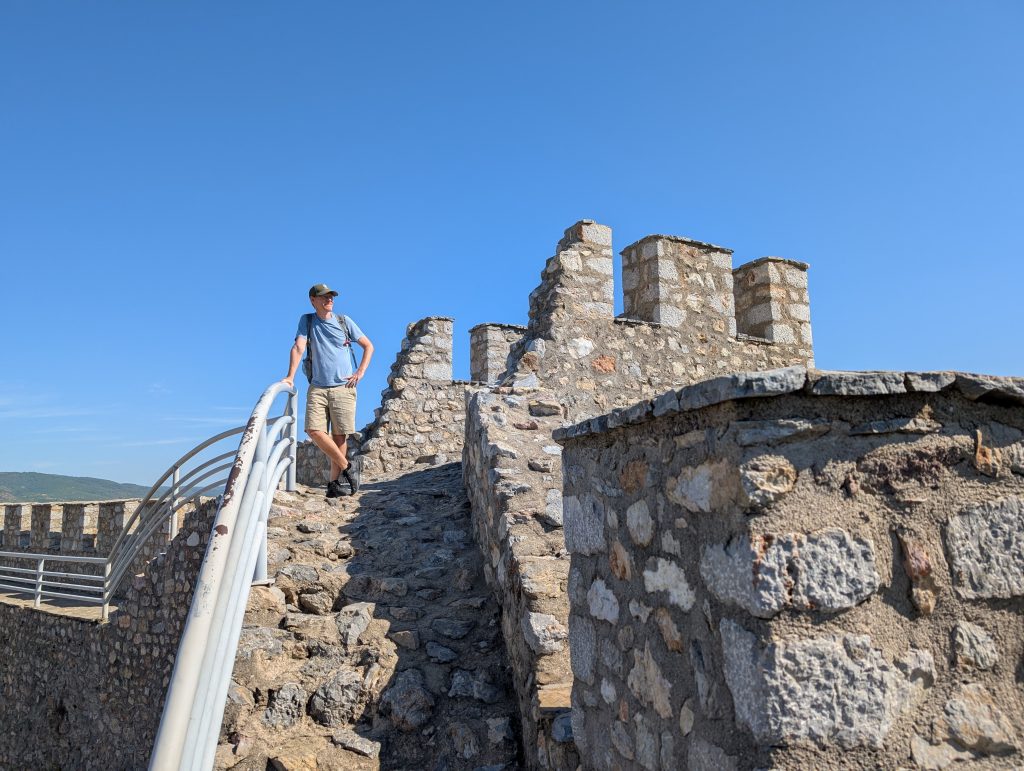
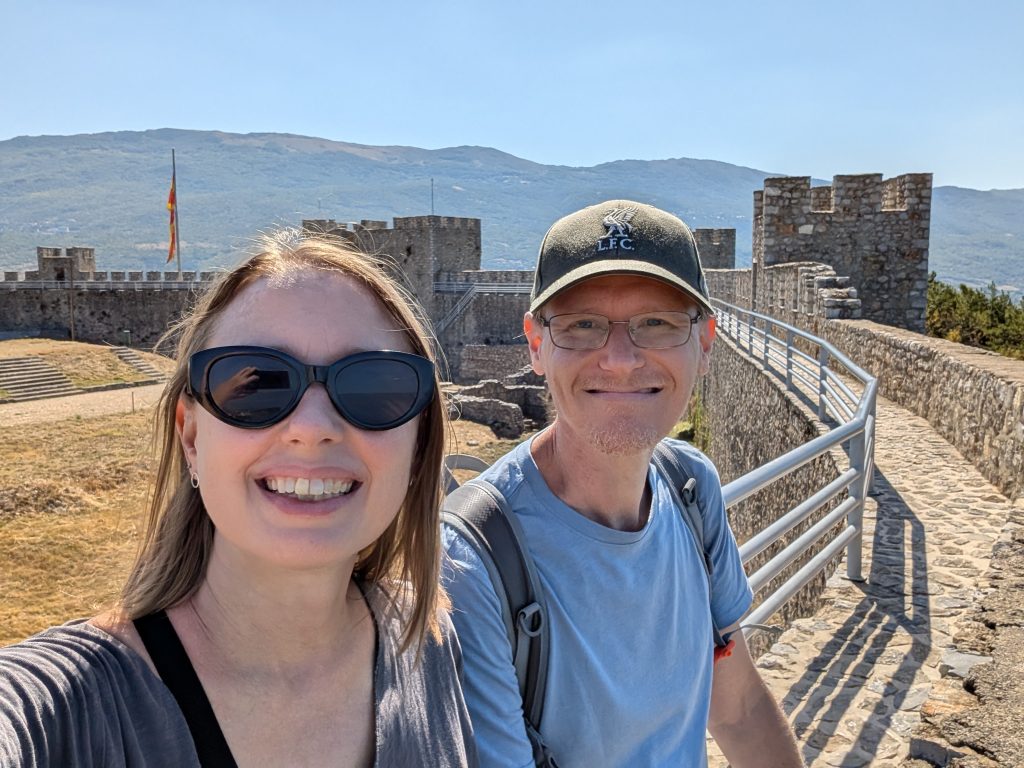
After the fortress, I was fading so we stopped at a nearby cafe appropriately called Fort Cafe for a juice (for me) and cappuccino (for Chad). The cafe was super-cute with lots of antiques and had fabulous views. It was a perfect break stop. We made a mental note to return one evening for a pre-dinner drink. It was actually just the type of place we’d looked for the prior evening before settling for the so-so lakeside place.
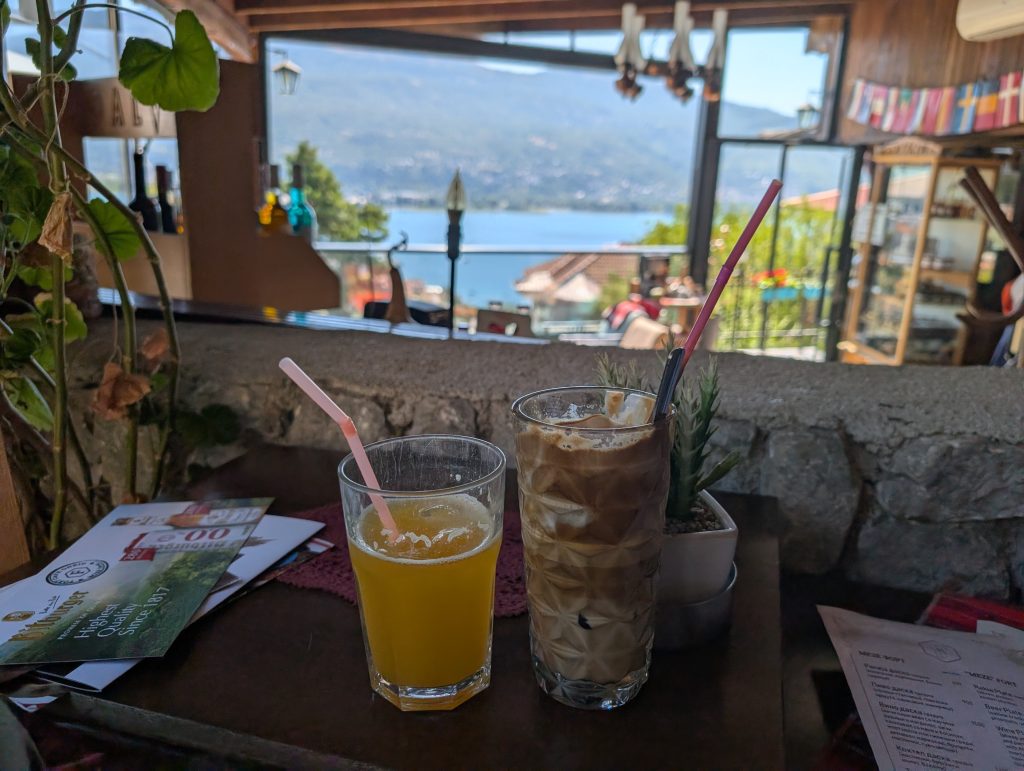
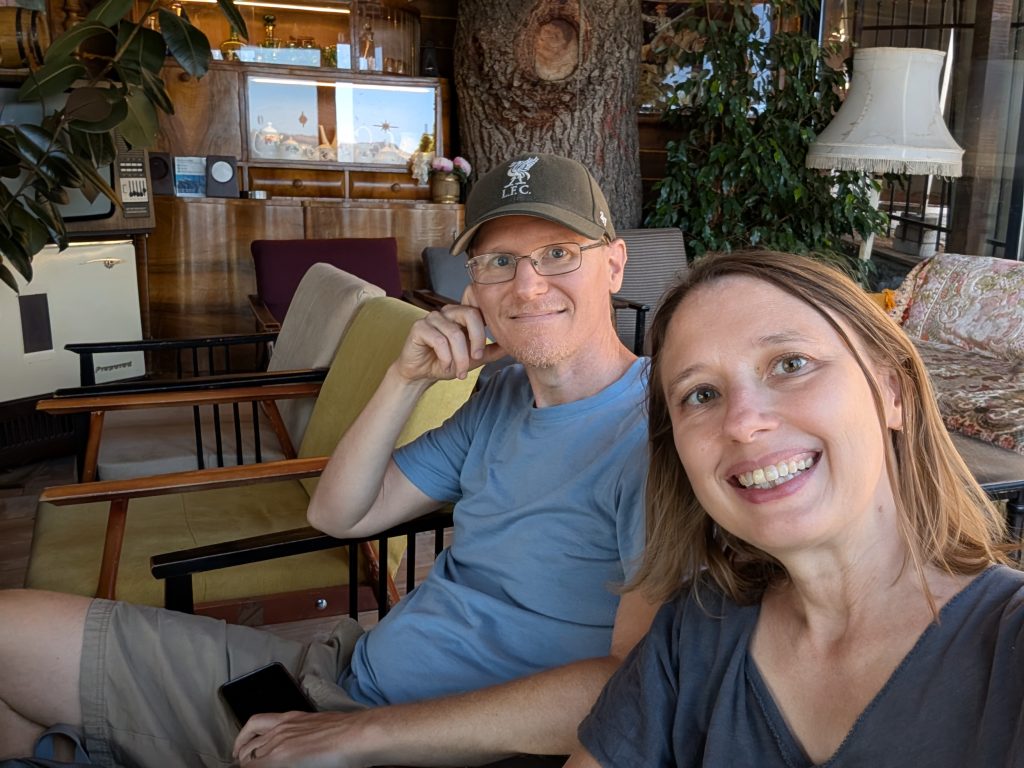
Restored, we went on past the Ancient Macedonian Theatre of Lychnidos (this one Greek rather than Roman, but it is kind of amazing how many European cities have amphitheater ruins) to the Church of the Virgin Mary Peribleptos. This 13th century church was not destroyed or converted by the Ottomans, but left as the main Orthodox cathedral under their rule. Though its frescoes were not plastered over, they’ve also required restoration due to damage from soot and dirt. Unfortunately again, no photos were allowed inside, but they were quite pretty. The icon gallery is next door, but also didn’t allow photos. It was quite small but did provide an opportunity for a closer look at some of the religious art and how it changed from the 10th through 18th centuries, and inspired us to look up some of the stories surrounding various saints.
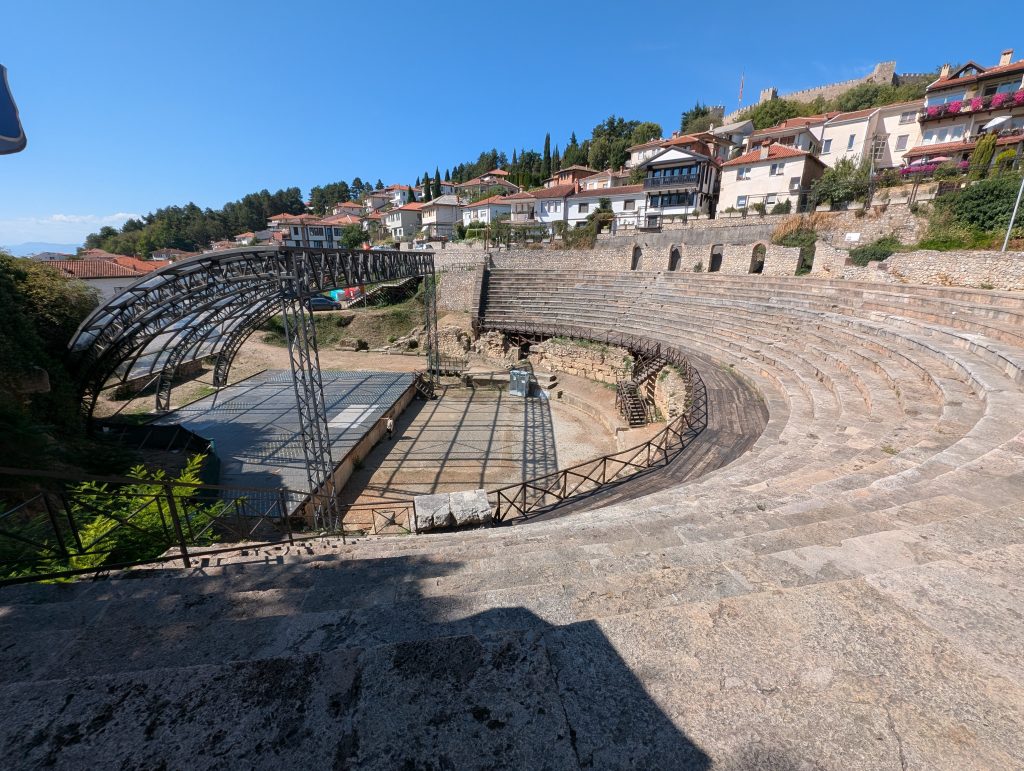
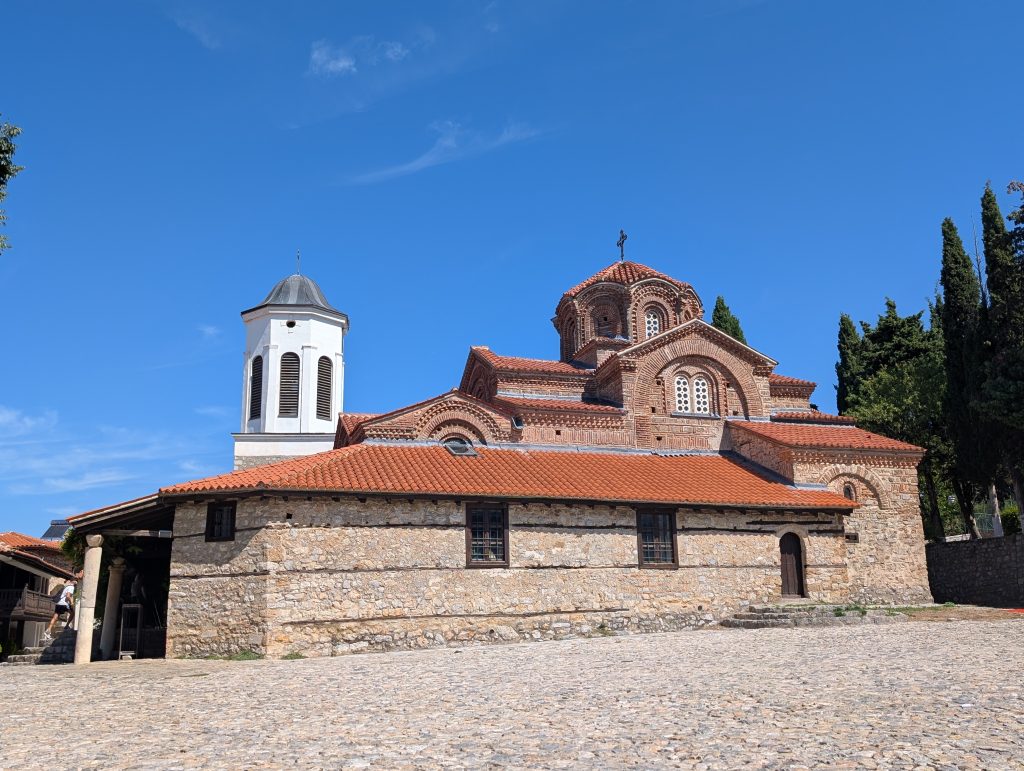
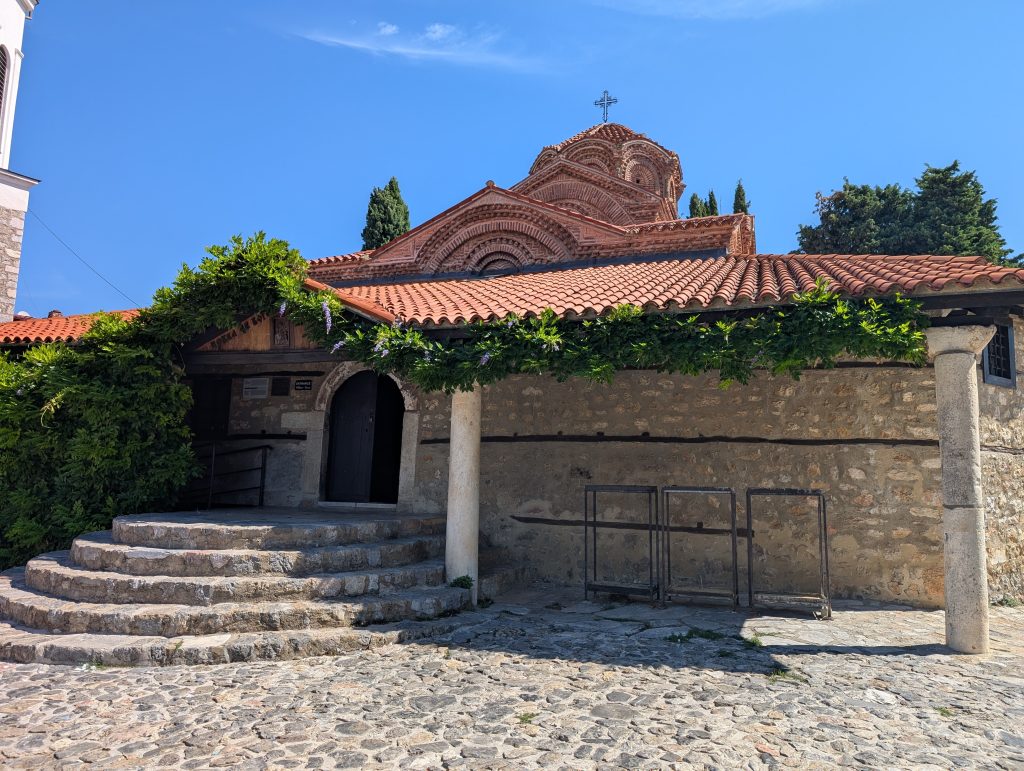
We made a brief stop at the free National Workshop For Handmade Paper, a small shop that still makes paper in the old style and prints on a Gutenberg press. It was neat seeing the process and we were tempted to buy a small print as a souvenir but ultimately decided we didn’t really have a good place to display it.
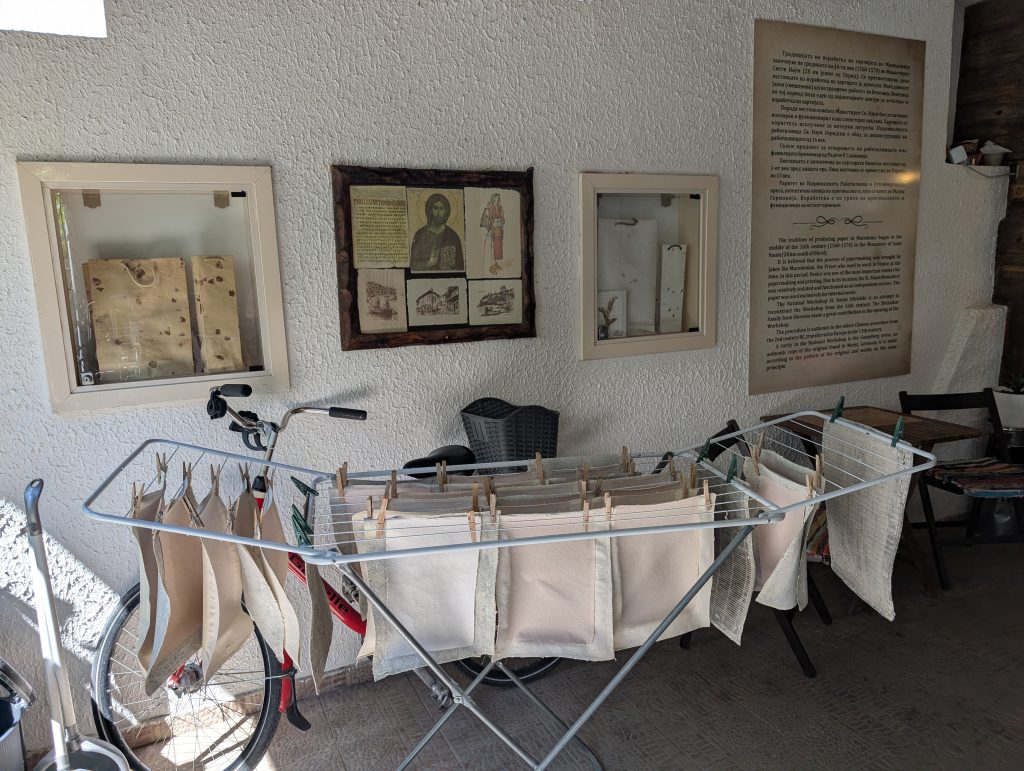
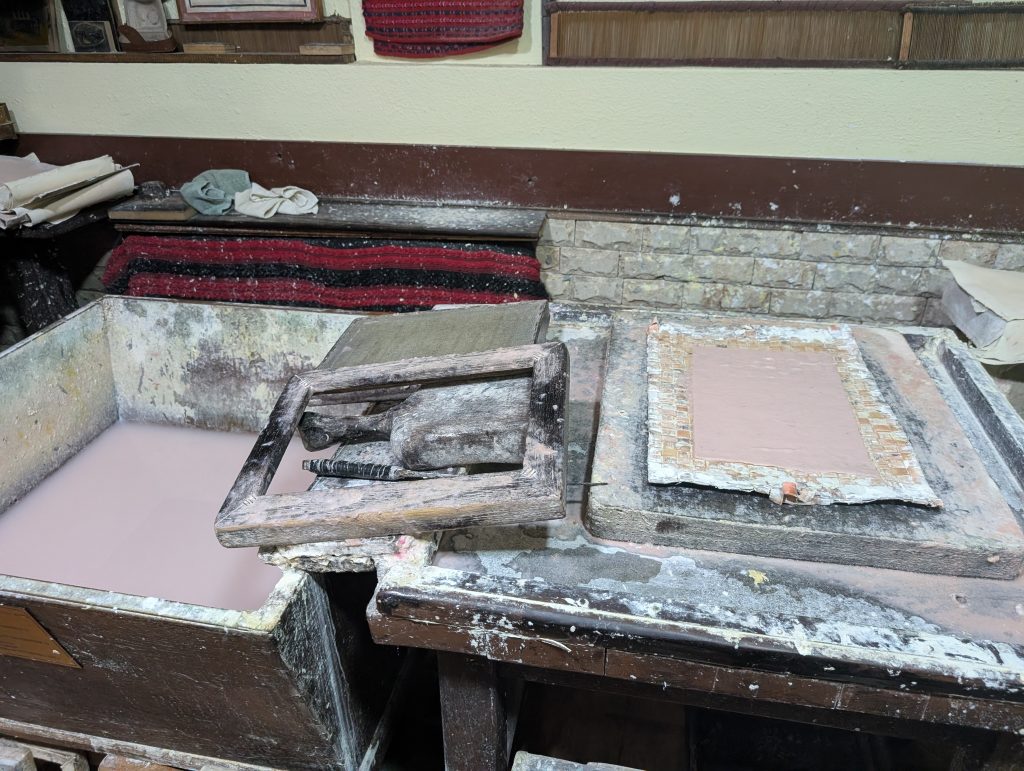
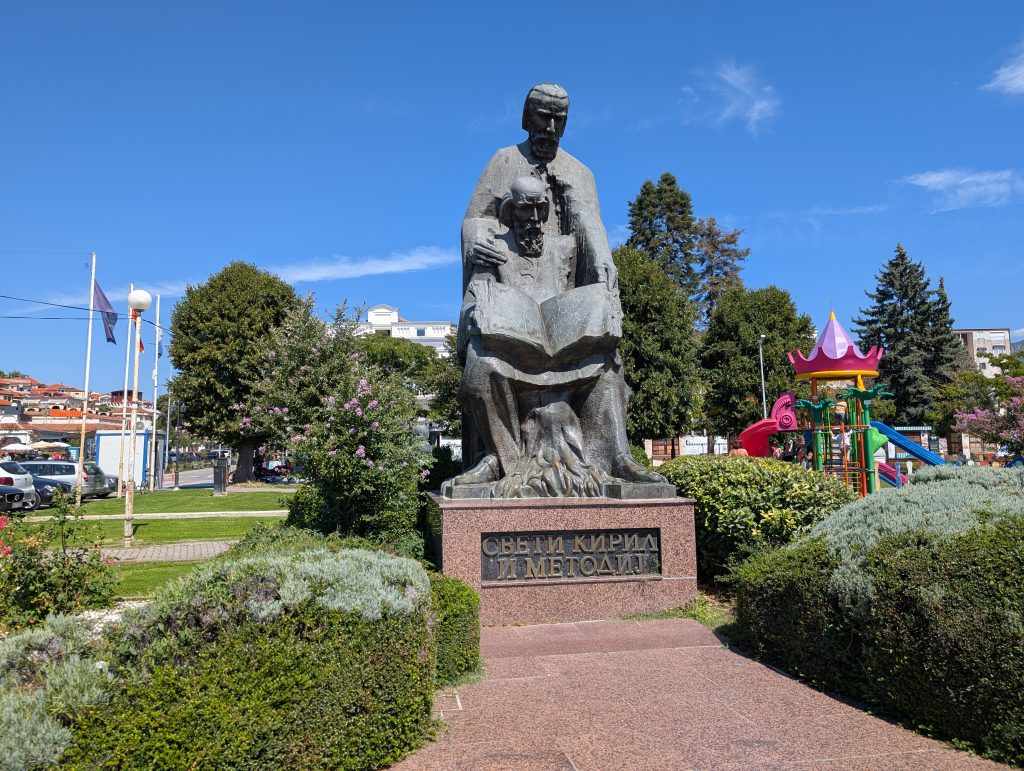
We capped our tour with a picnic of Macedonian burek by the lake. Burek is a traditional pastry found in several Balkan countries made of filo dough and filling. We got one with meat and one with cheese from Bakery Lihnida and they were very tasty.
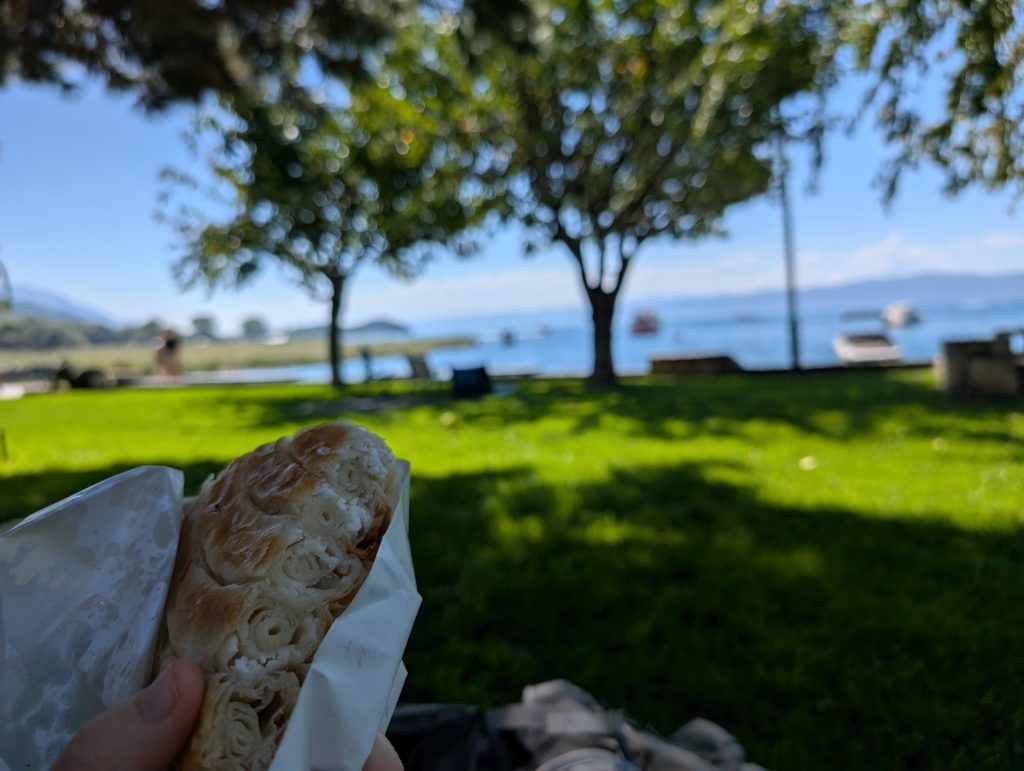
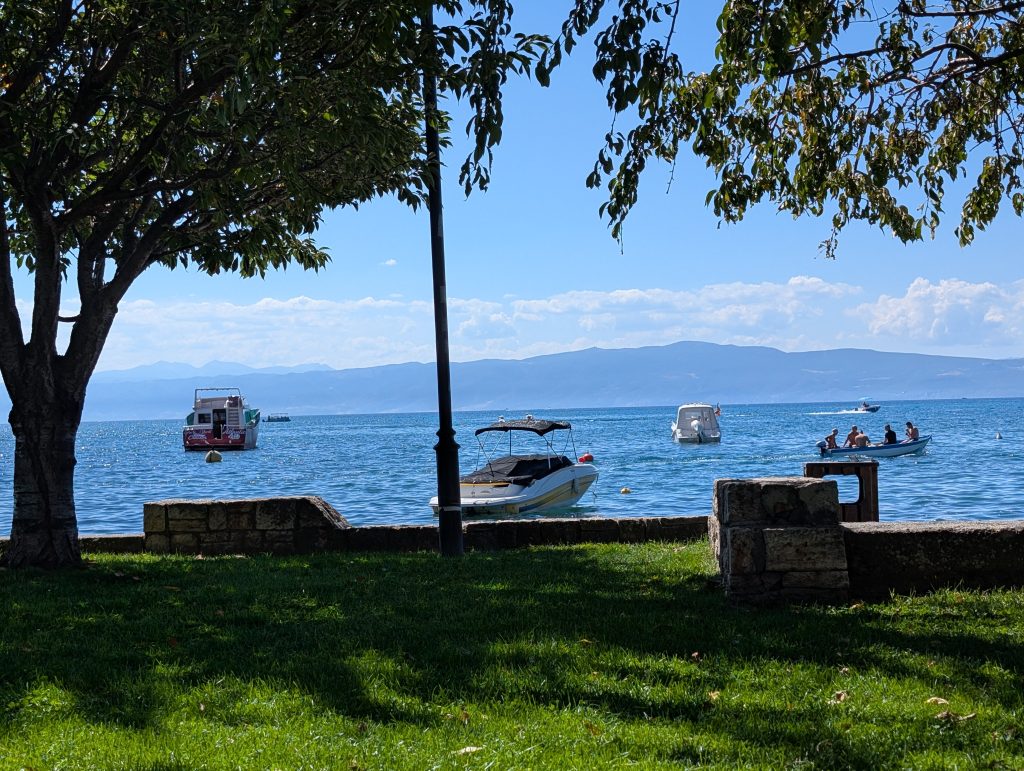
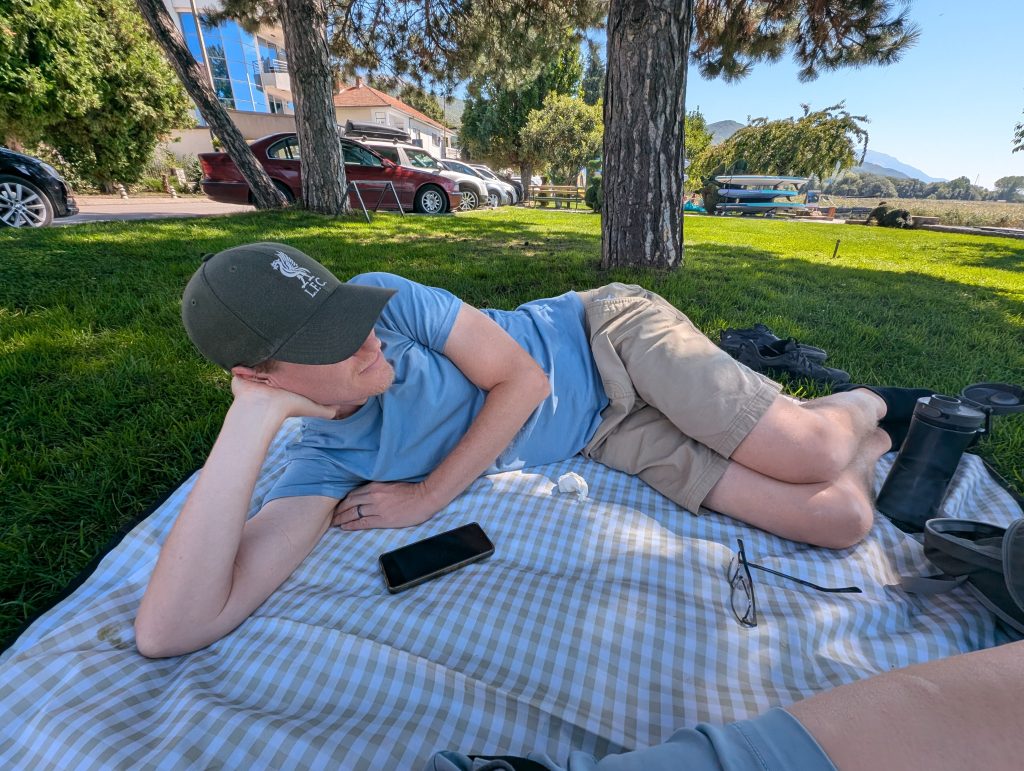
After a rest, we decided we were up for a little more sightseeing, so we visited the Robevci Family House museum, a 19th century house with displays from the Ohrid cultural association, including many of the archeological findings from the area. Then we walked back up the hill to the Fort Cafe to enjoy a nice beer with a view, realizing our next/final day’s plans might not allow for it. We enjoyed it as expected then headed home to enjoy the sunset from our balcony and our stir fry leftovers.
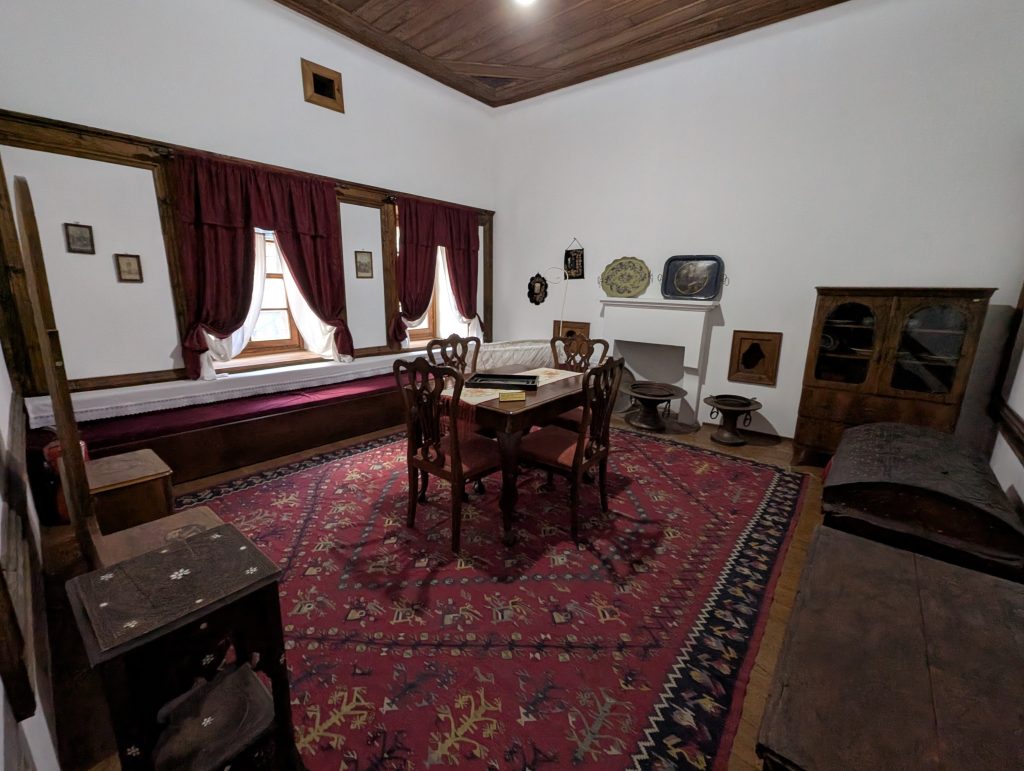
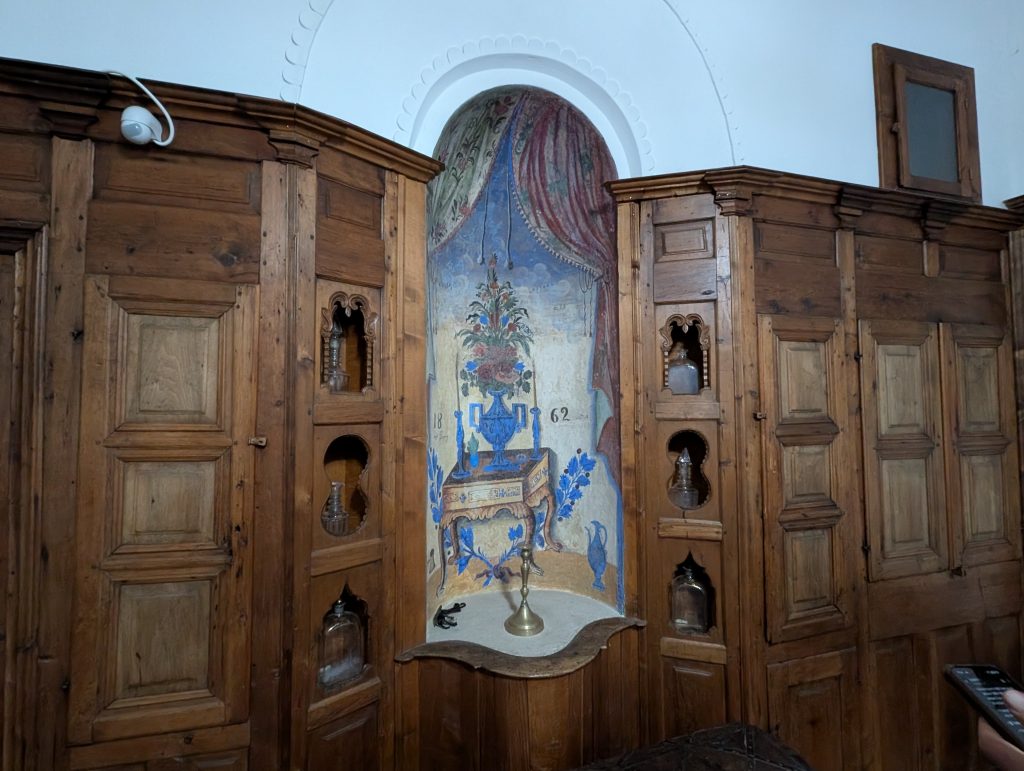
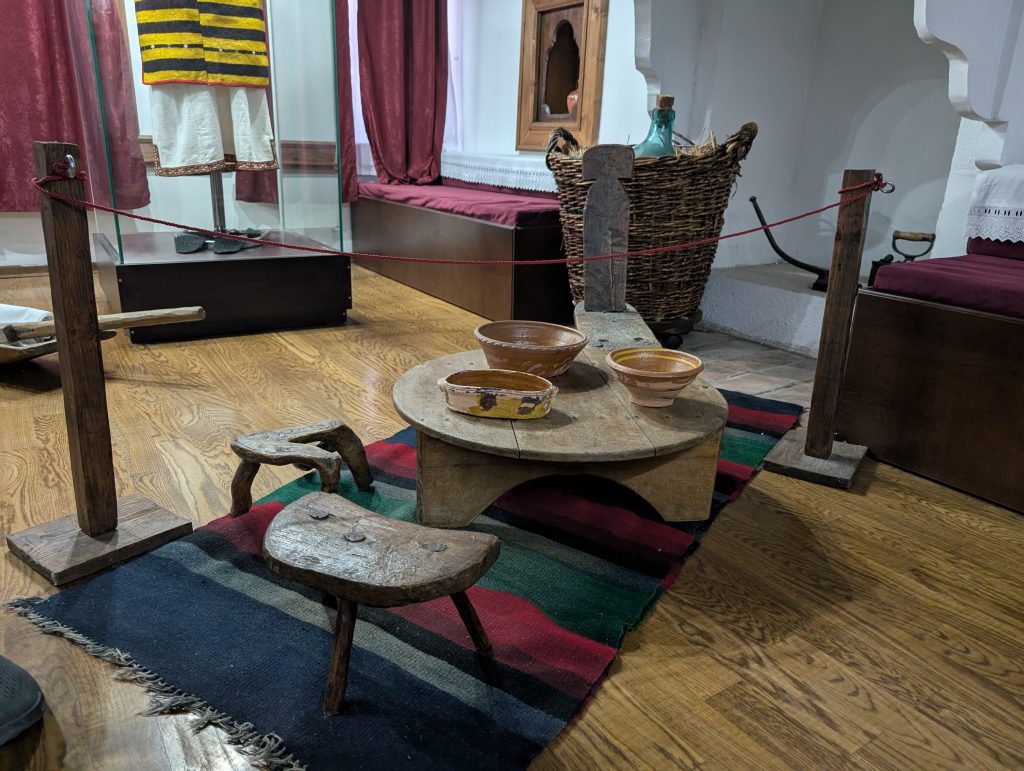
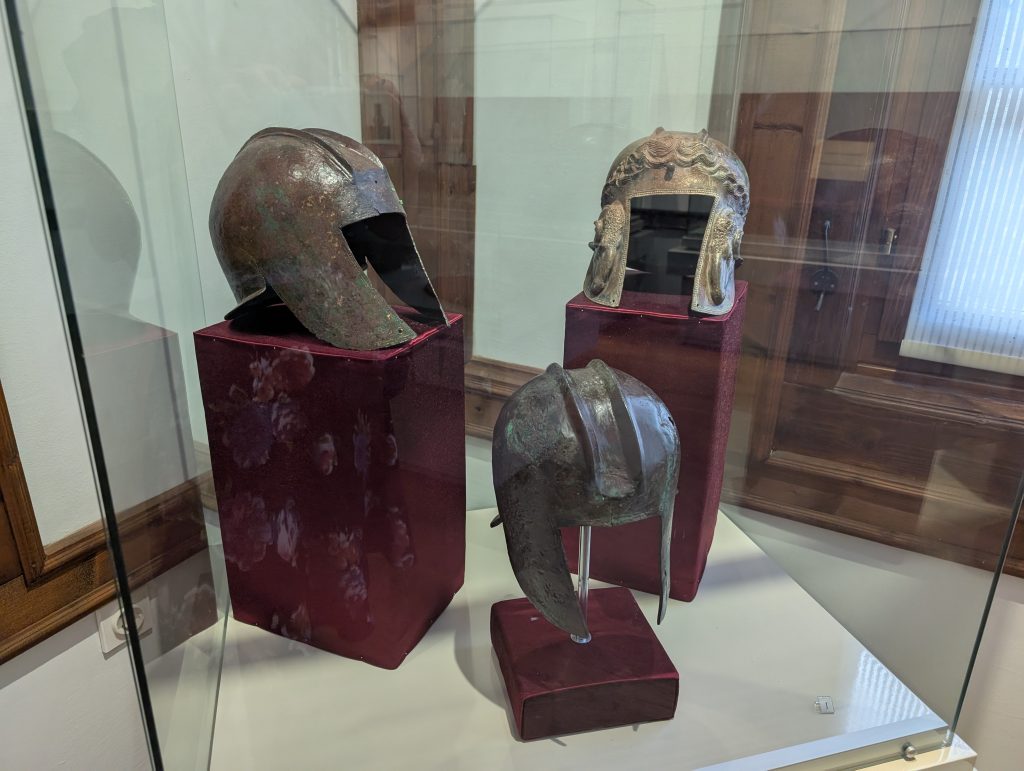
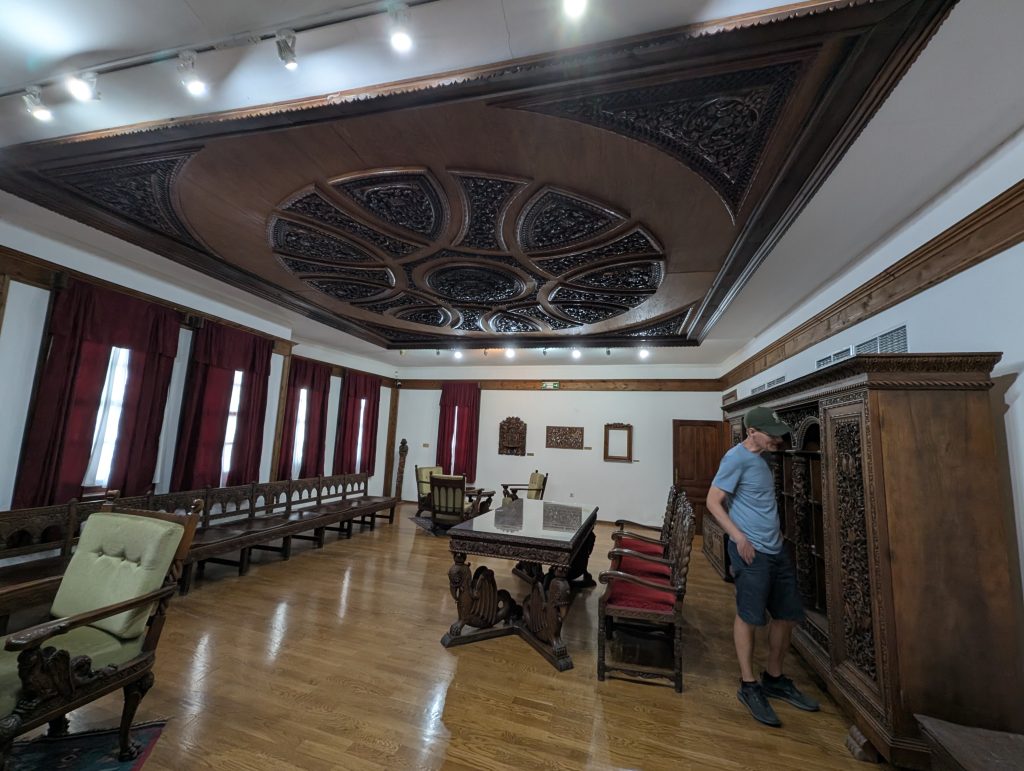
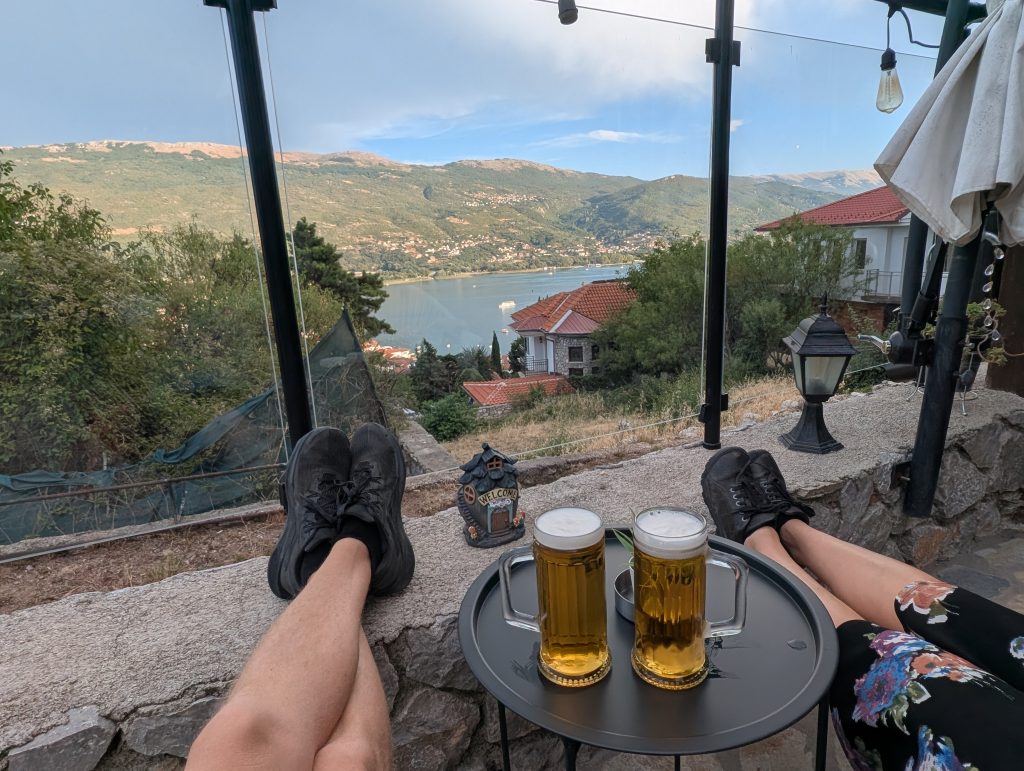
Boatride to St. Naum
Sunday was our last day in Ohrid and we booked a full-day tour to cross the lake to St. Naum on the Boat Armada. We arrived early to make sure we’d get upstairs seats, though I wish we’d chosen the right side of the boat rather than the left, because we’d have had more shade in both directions. But with our hats it wasn’t too bad and it was nice to be on the water.
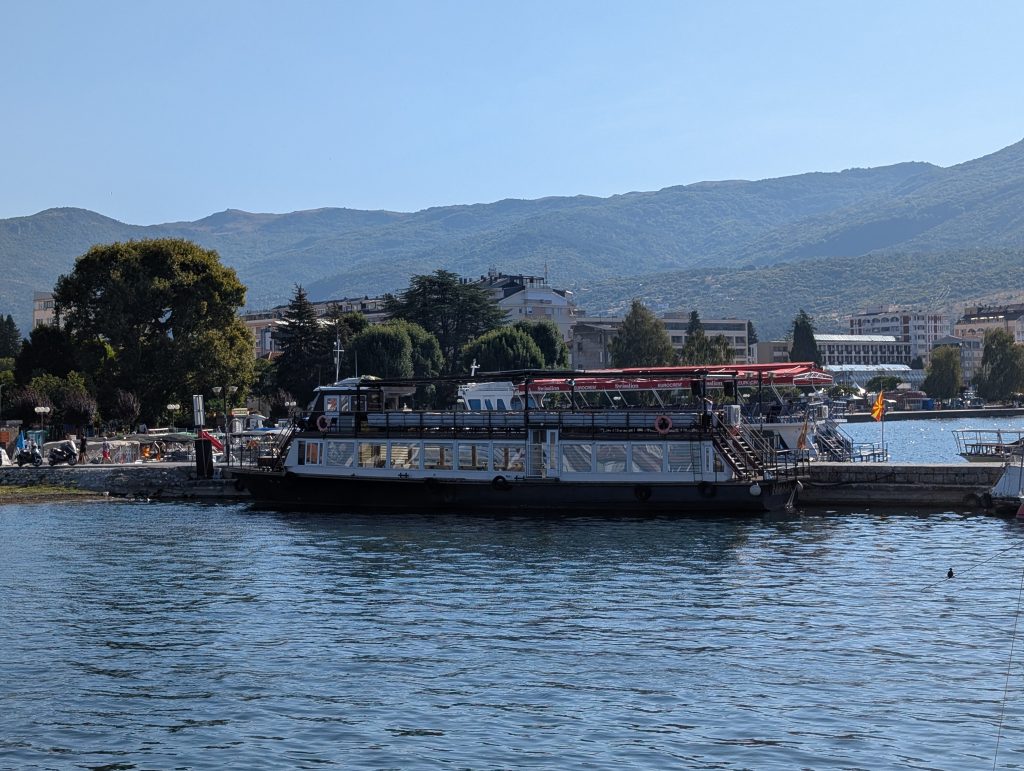
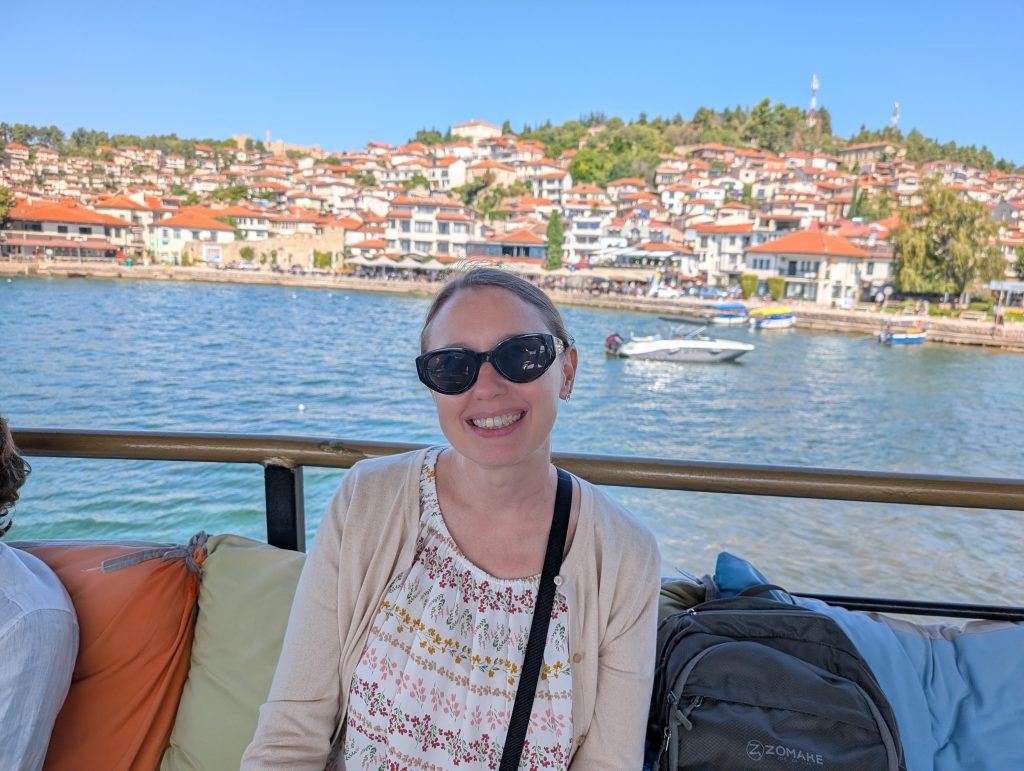
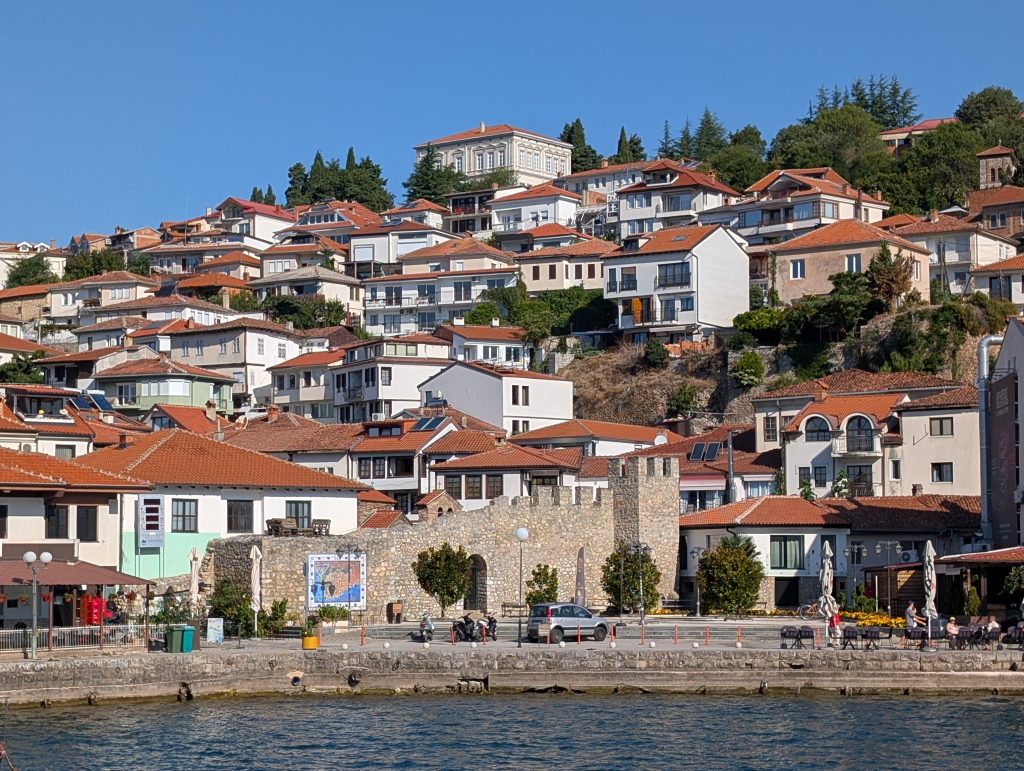
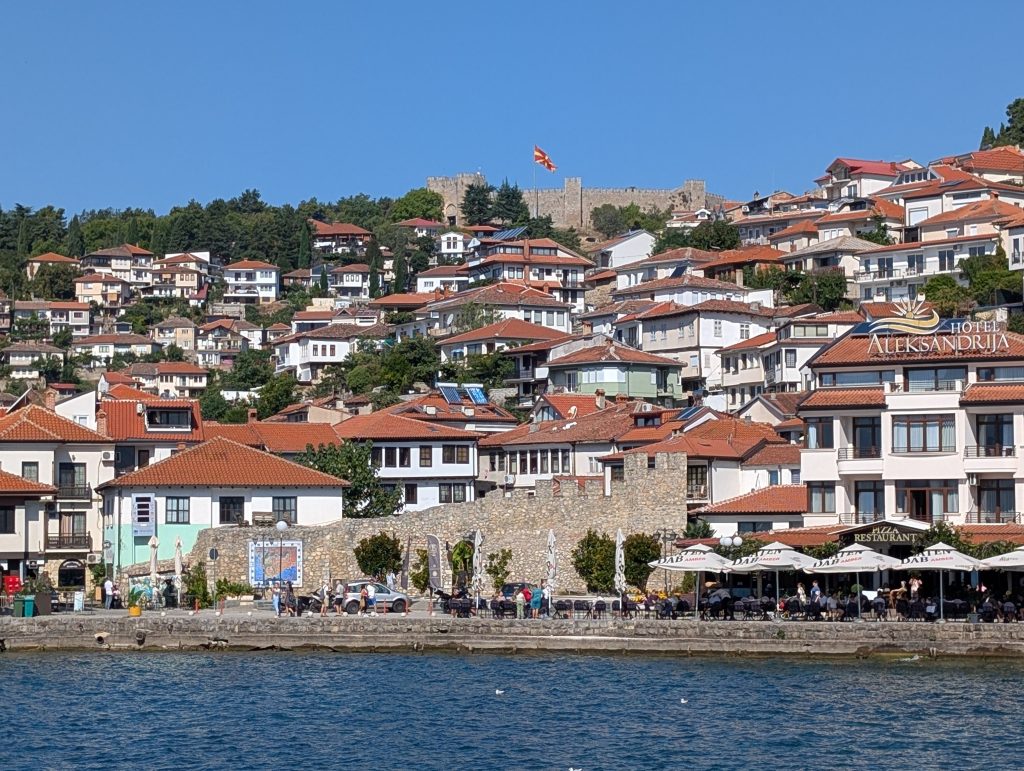
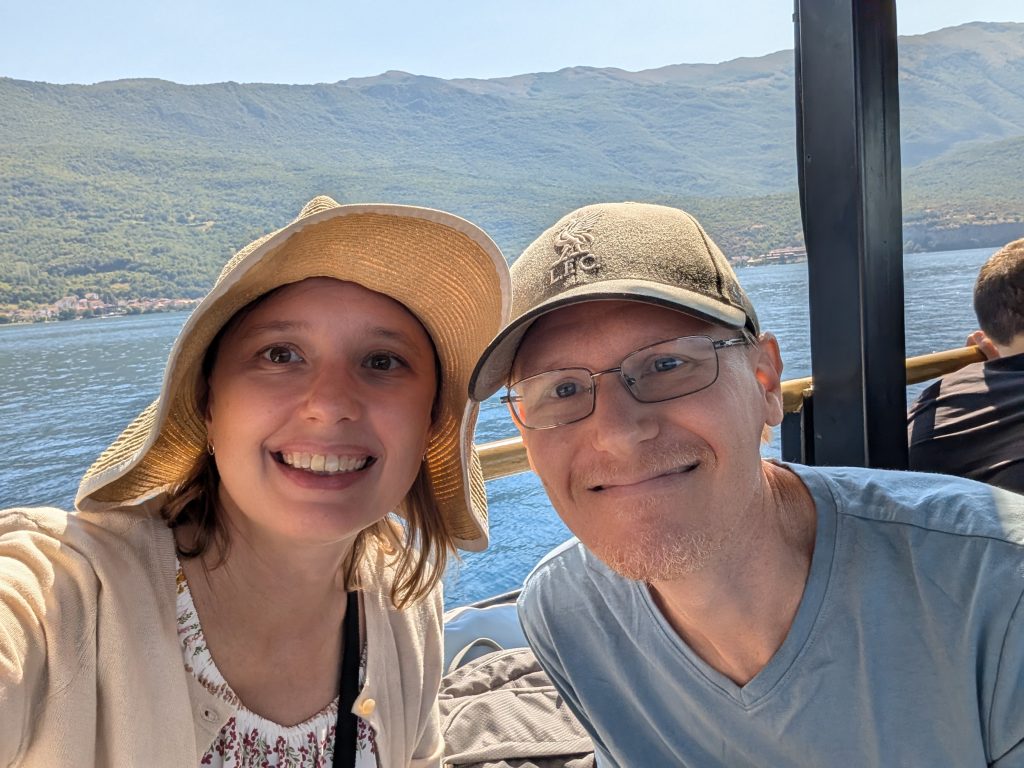
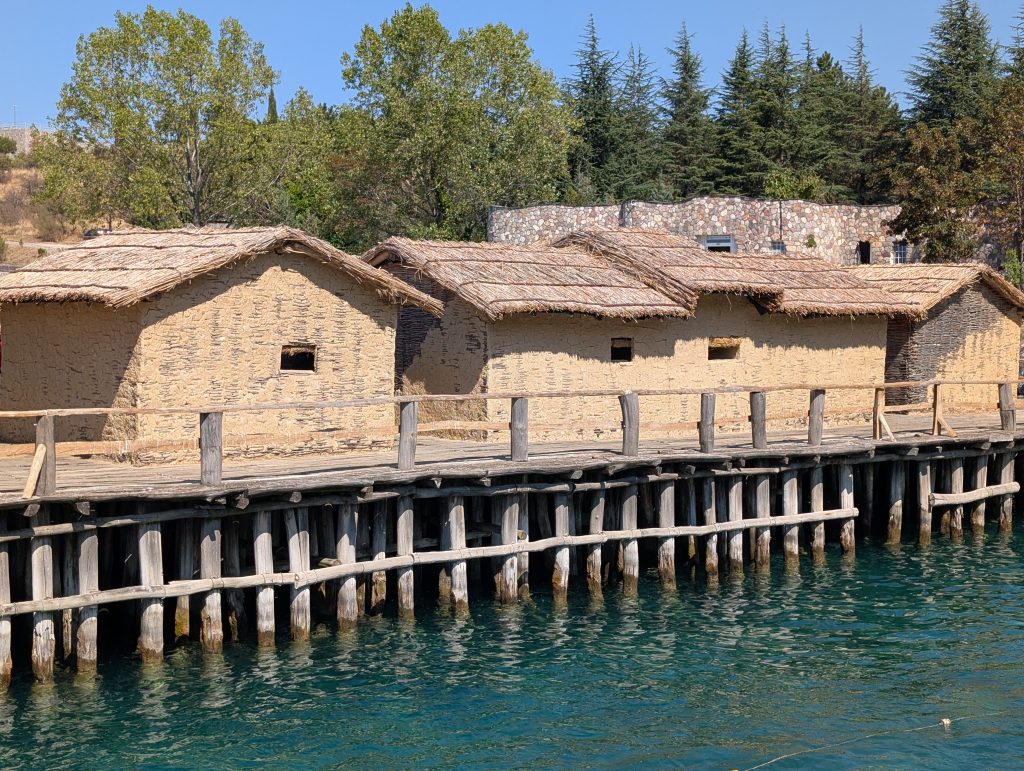
We first stopped at the Bay of Bones, about 90 minutes by boat to the south, which is a reconstruction of Bronze and Iron Age stilt houses. It struck us as a bit of a tourist trap so we just stretched our legs and returned to the boat. After another 30 minutes ride, we arrived at St. Naum, a small town near the border with Albania named for the old monastery there, where we’d have about three hours of free time to explore.
We started our time in St. Naum with lunch, which was the right call because we lucked into a great table at Restaurant Ostrovo on a platform overlooking a natural spring that feeds into the lake. I’d researched this restaurant as having good vegetarian options but didn’t realize we’d have the fun seating as well. Our Macedonian meal was great again – salad with smoked trout, grilled eggplant with shredded cheese, a spinach pie with yogurt, and bread.
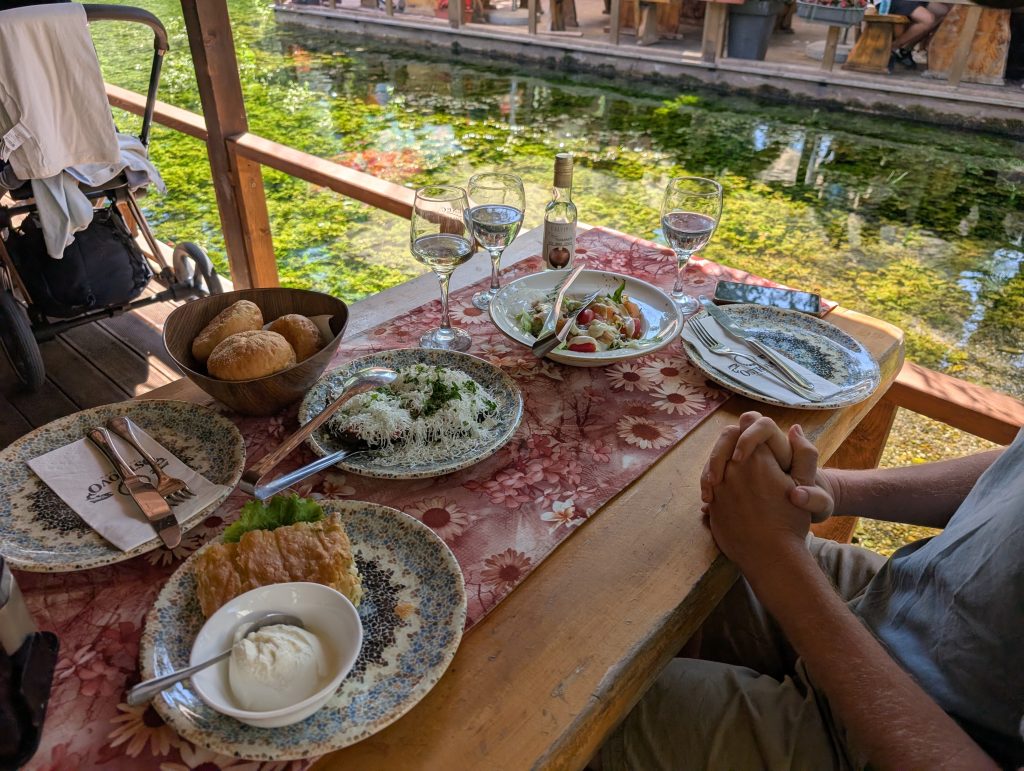
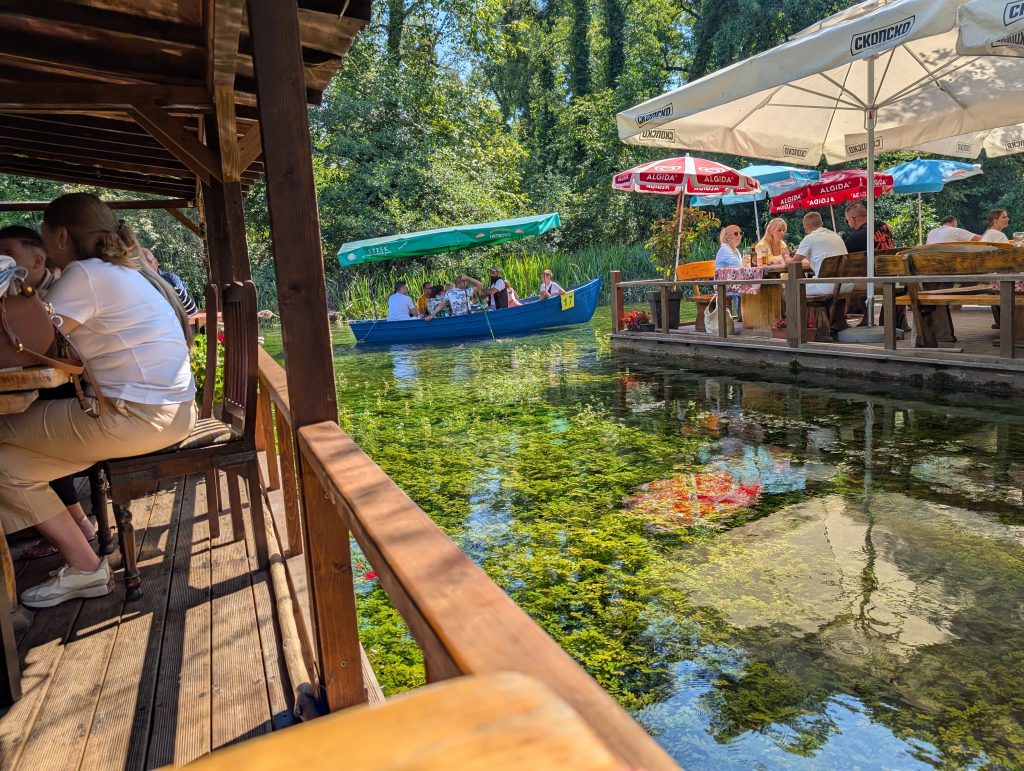
After lunch, we went up to St. Naum Monastery, founded in 905. We viewed inside the old church (150 denar fee and no photos allowed inside) and the new church by the gift shop (free and photos) and walked around the grounds. We backtracked to the beach area for a quick restroom stop then went back to the monastery grounds to walk on the trail by the spring. We got back on the boat a little early and had a relaxing two-hour ride back to Ohrid.
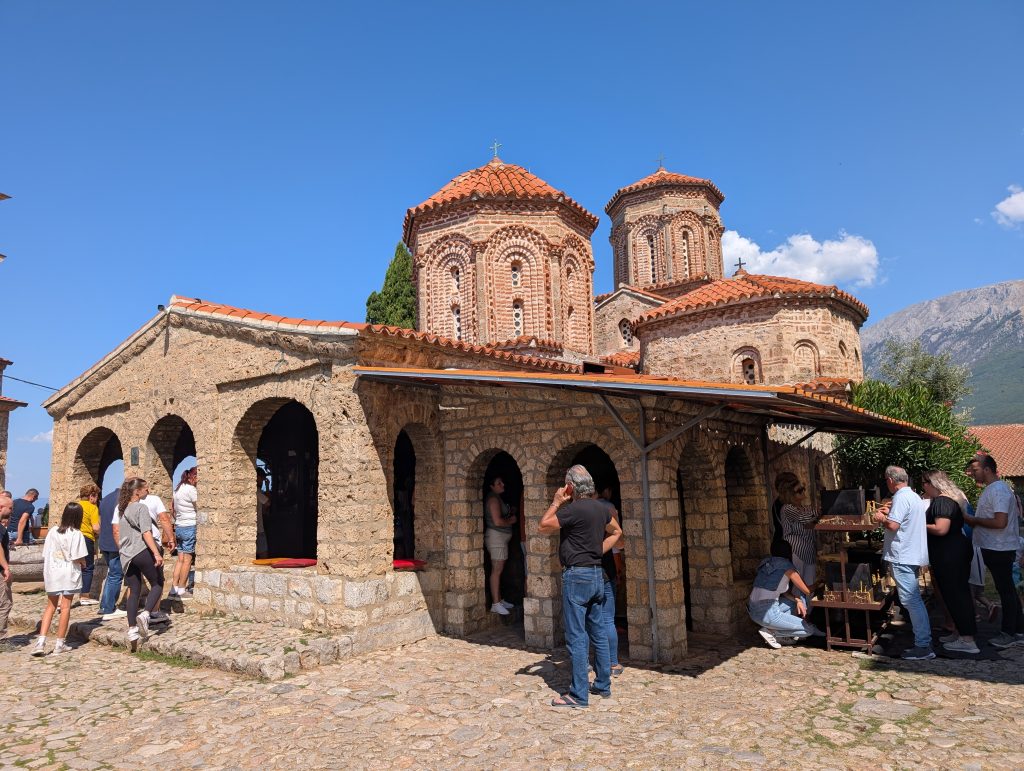
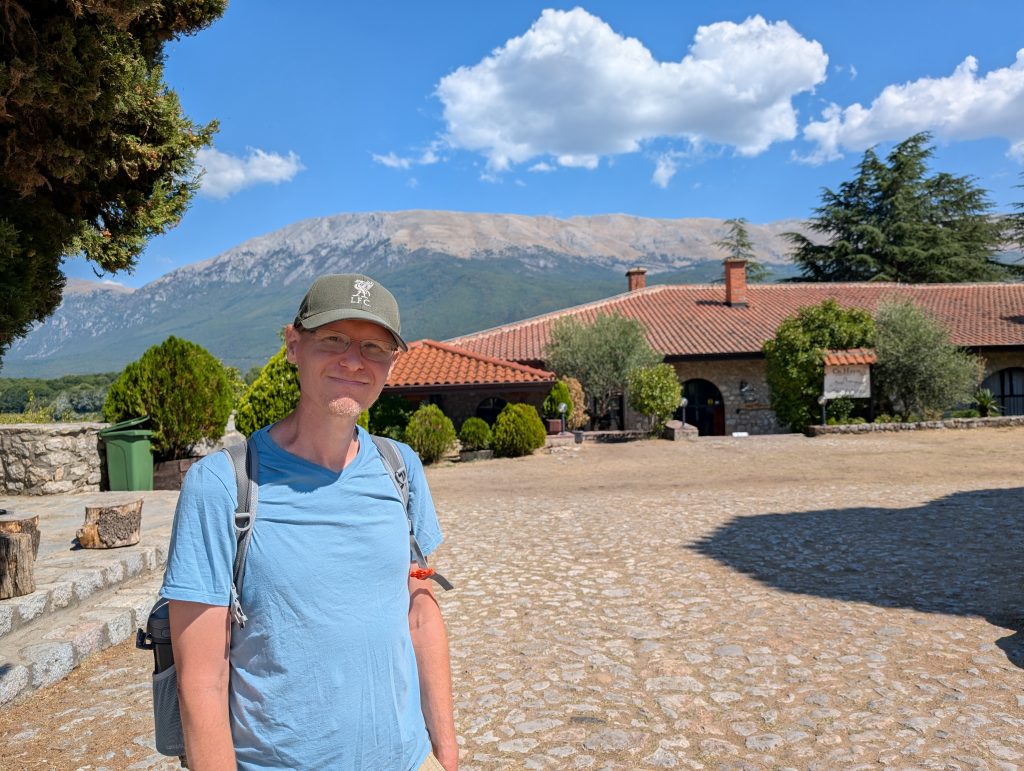
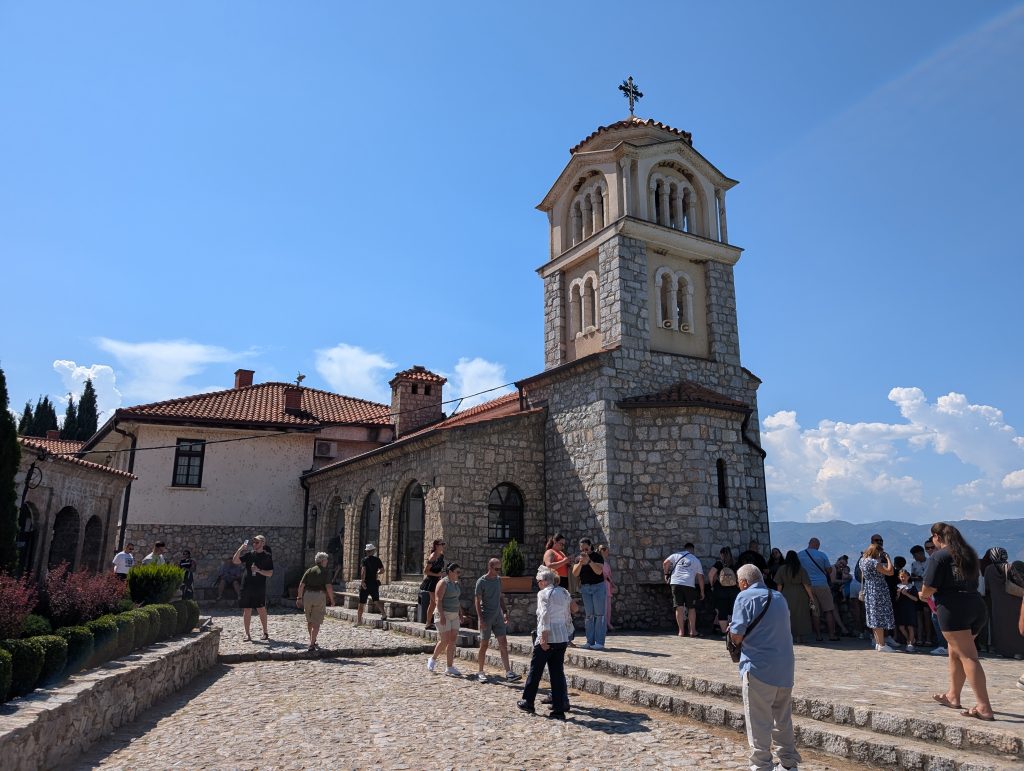
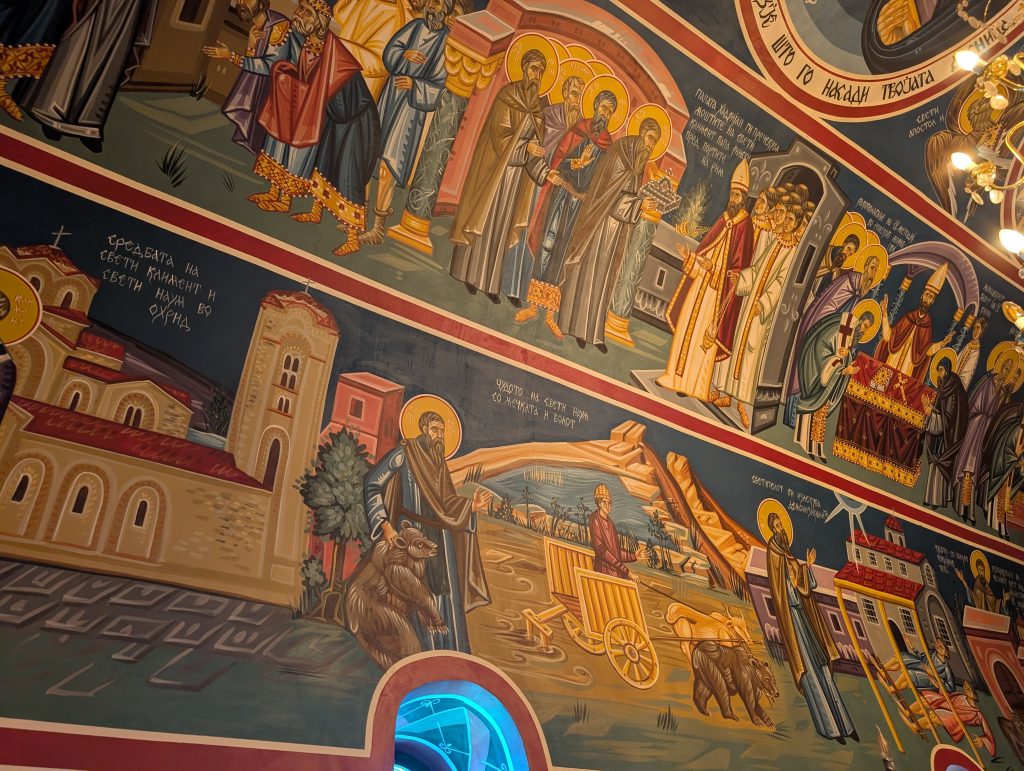
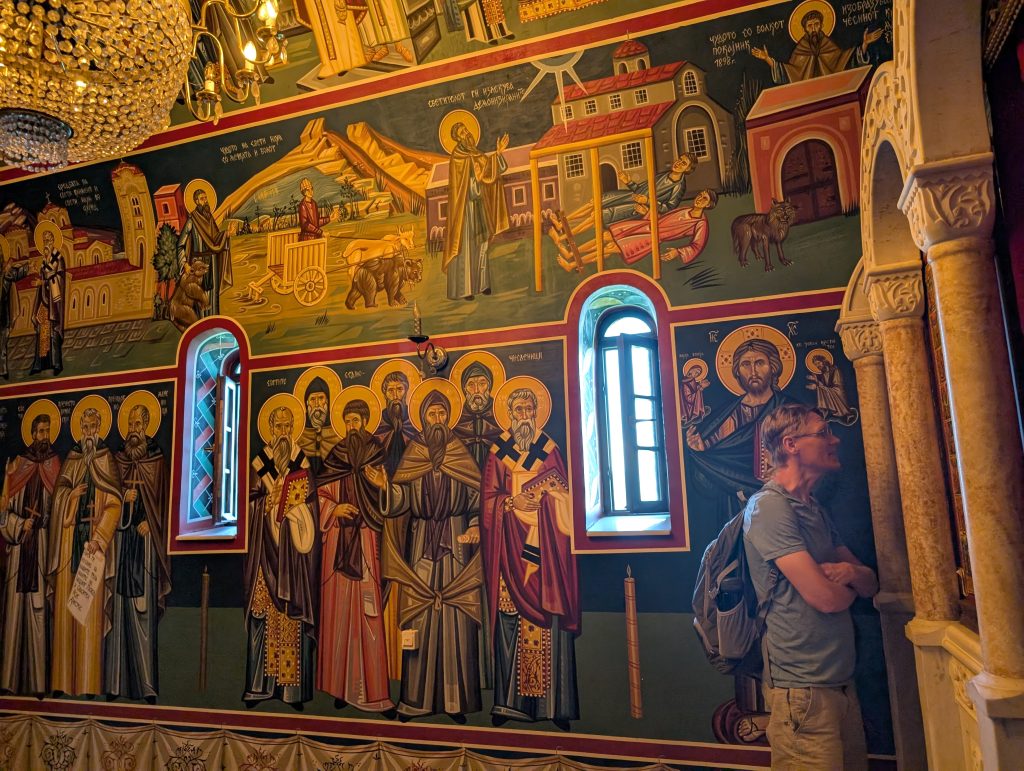
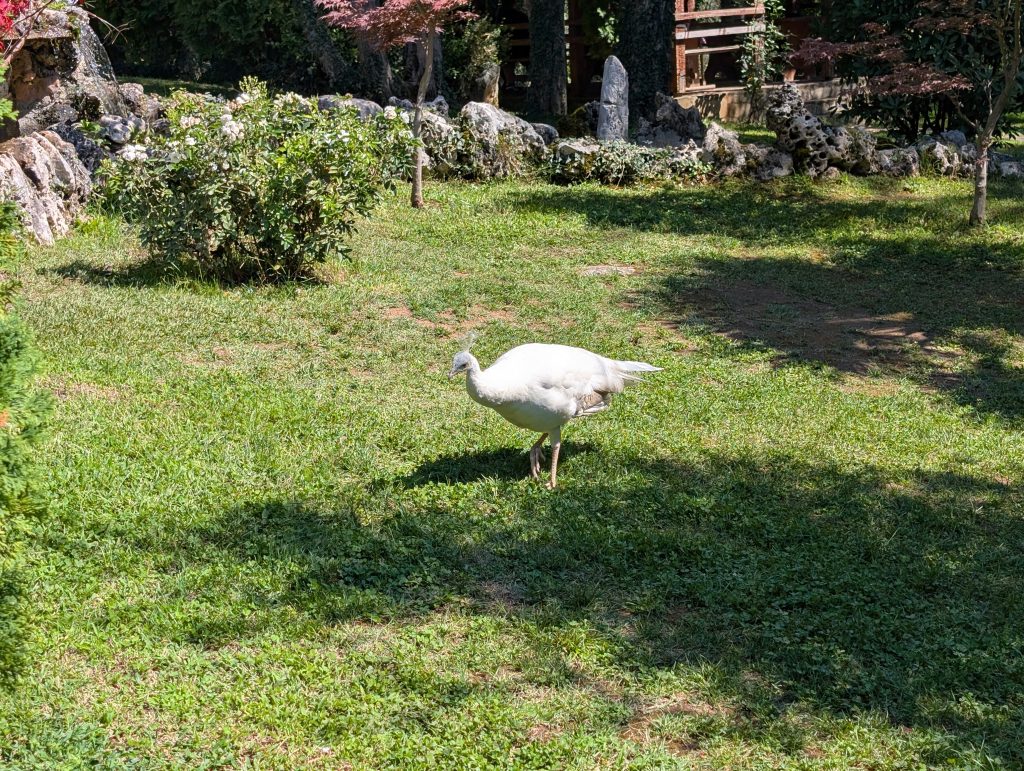
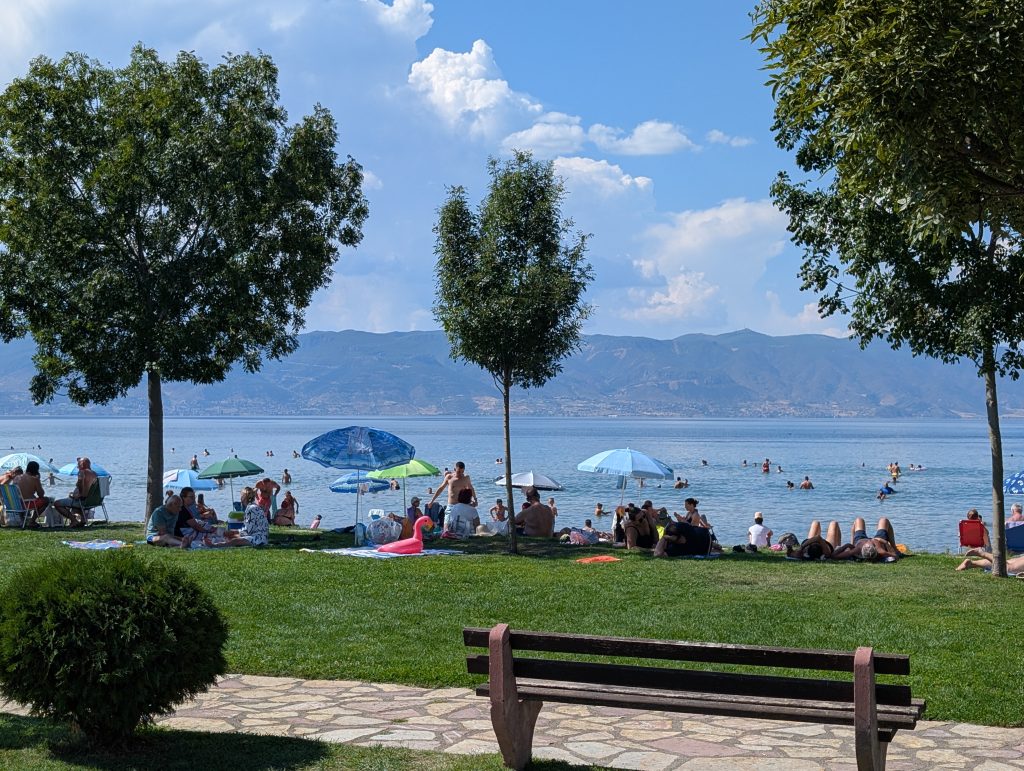
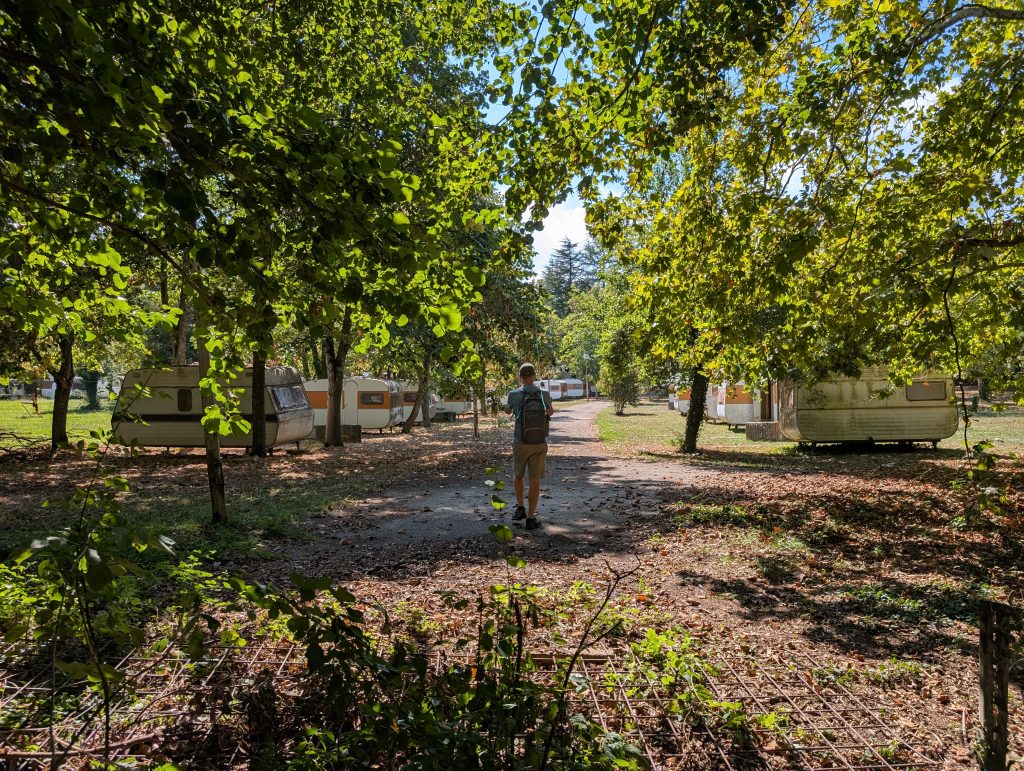
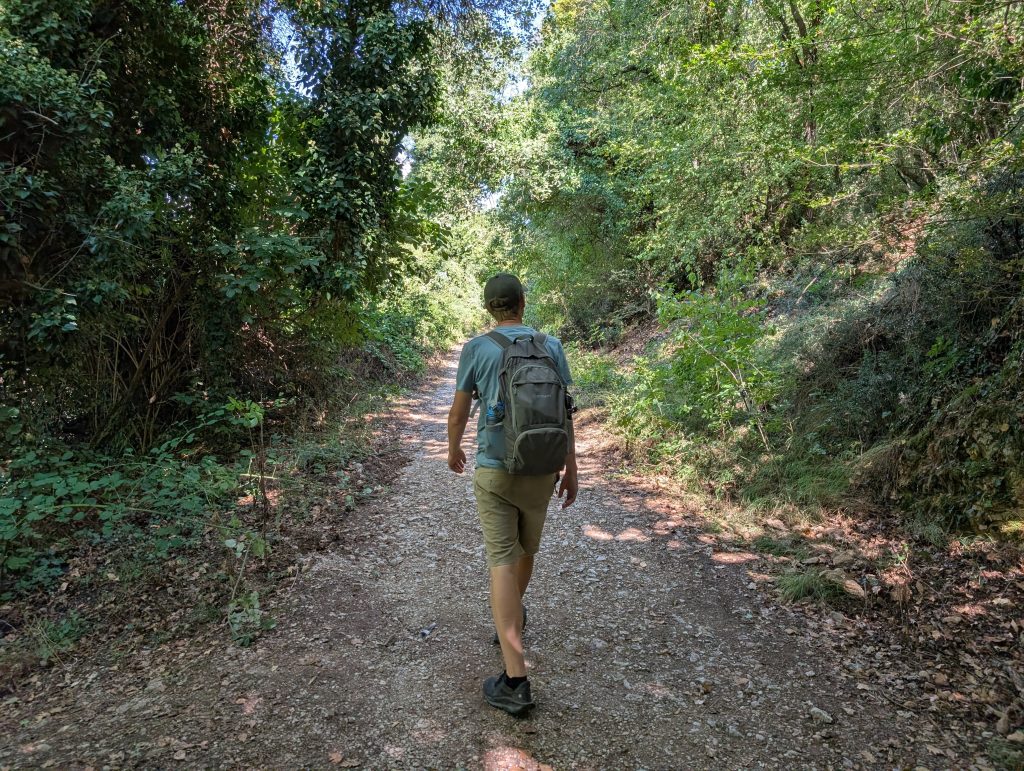
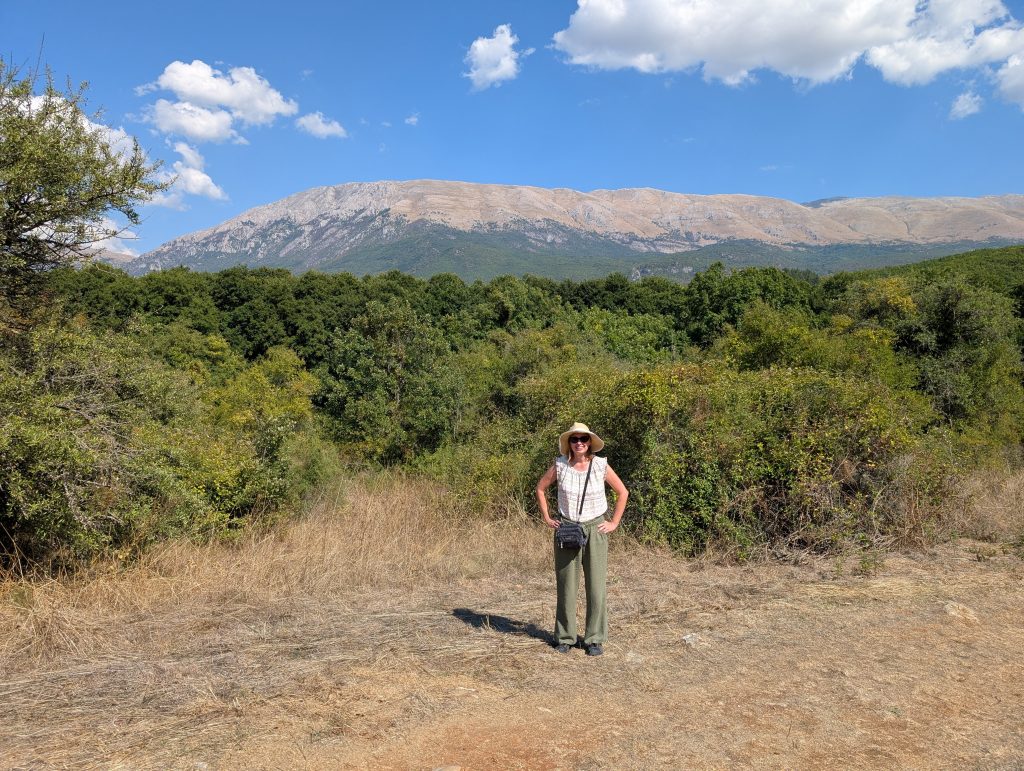
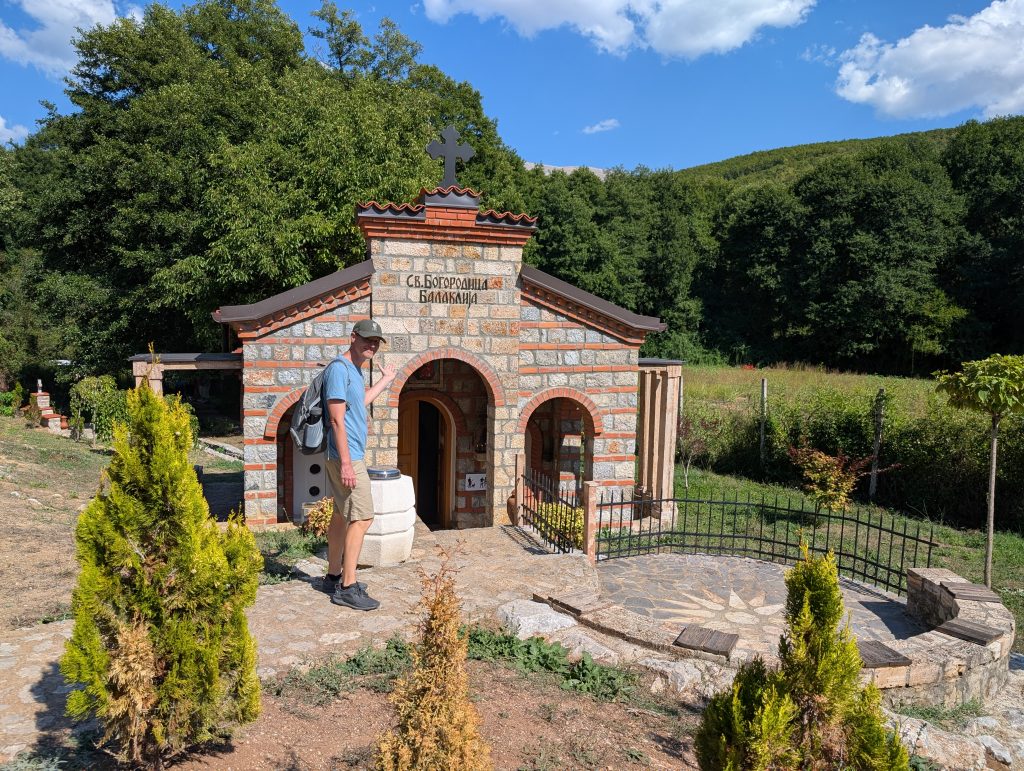
Our last meal out was at a lakeside restaurant I’d read about on a blog. We’d tried to get a Friday night reservation on our walk that day, but they were booked up so we made our reservation for Sunday night instead. We didn’t get much sense of being on the lake since it was dark but the atmosphere was nice and the food was good – salmon, pork with mushrooms, and a dessert inspired by Ferrero Rocher chocolate.
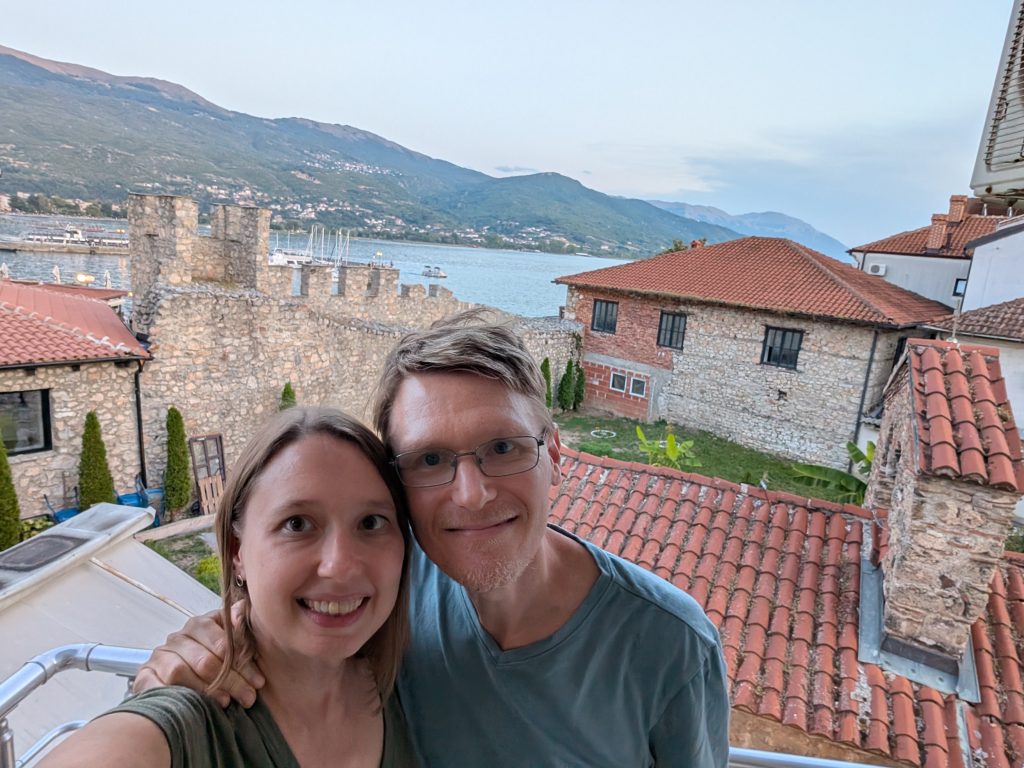
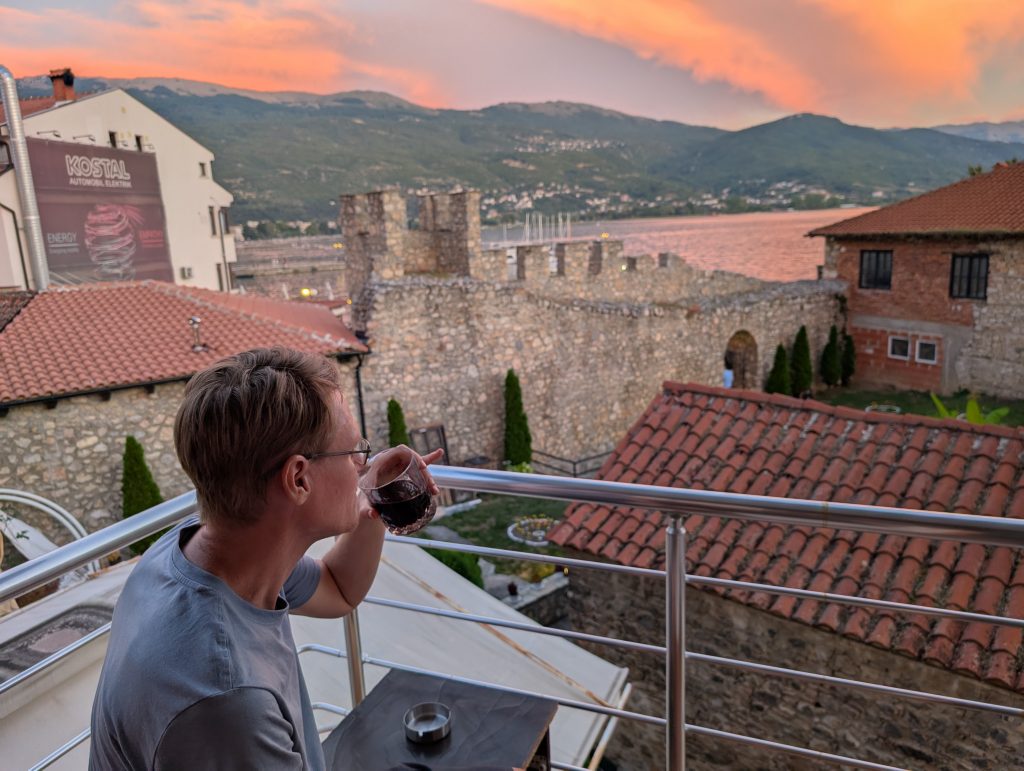
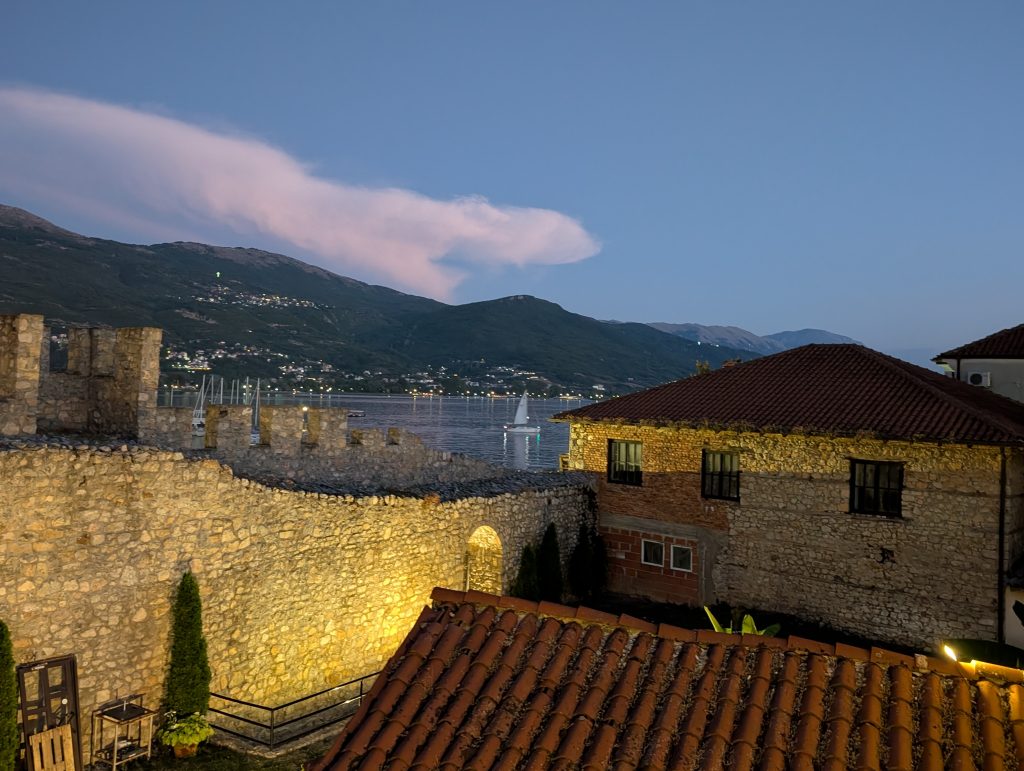
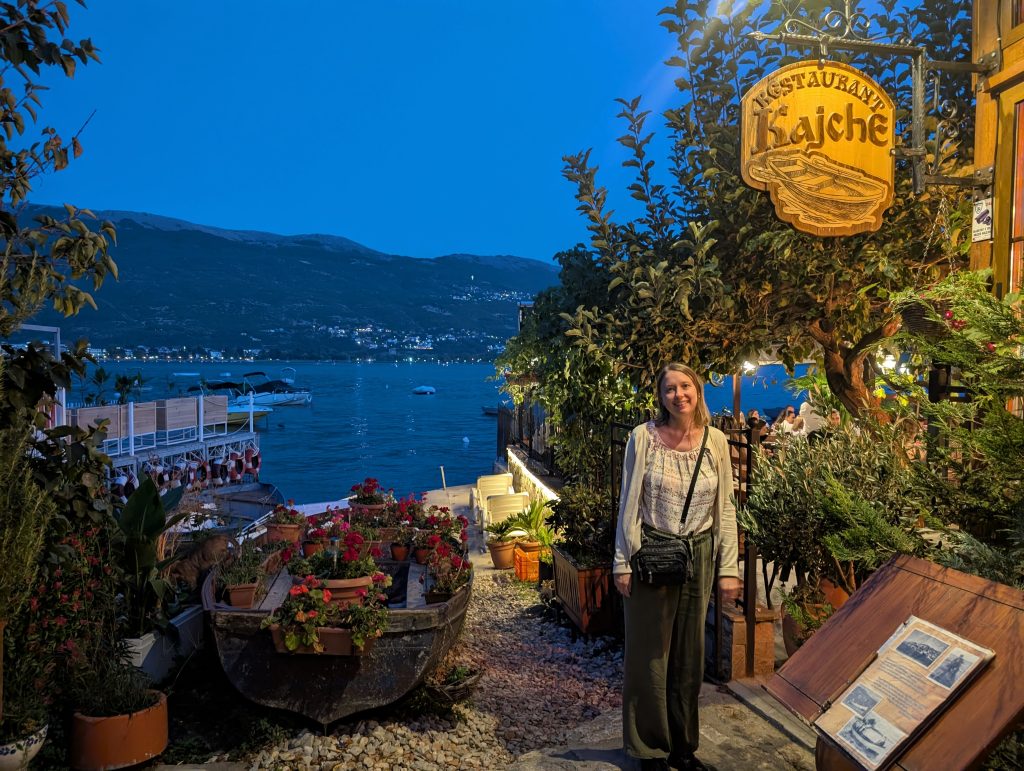
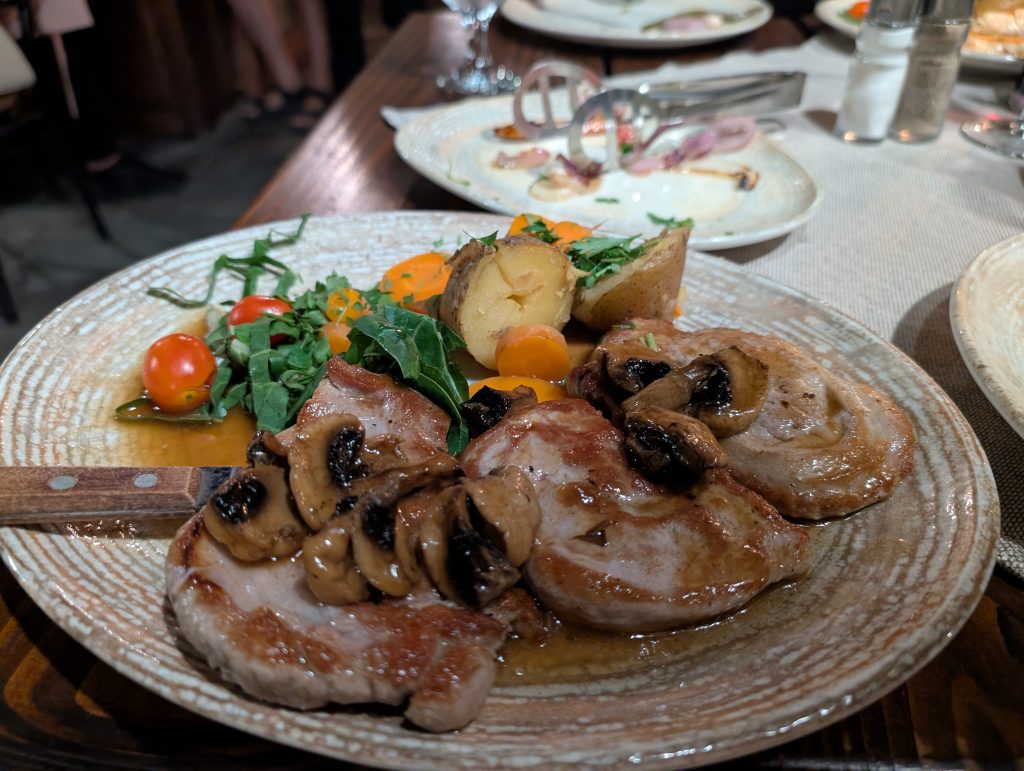
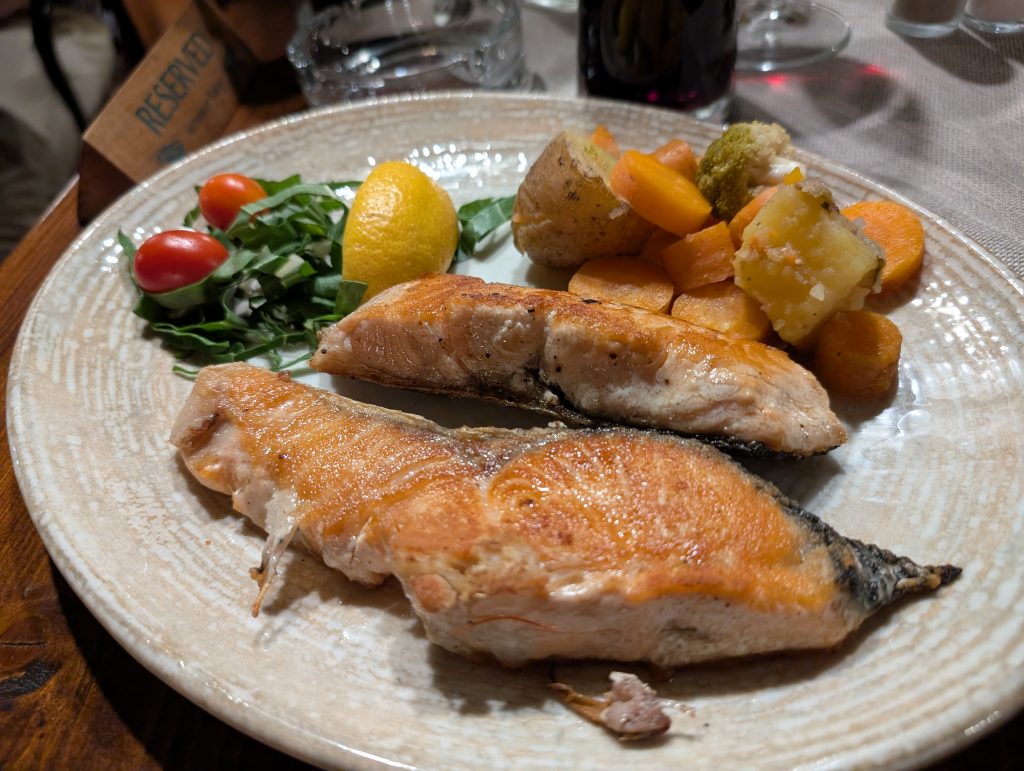
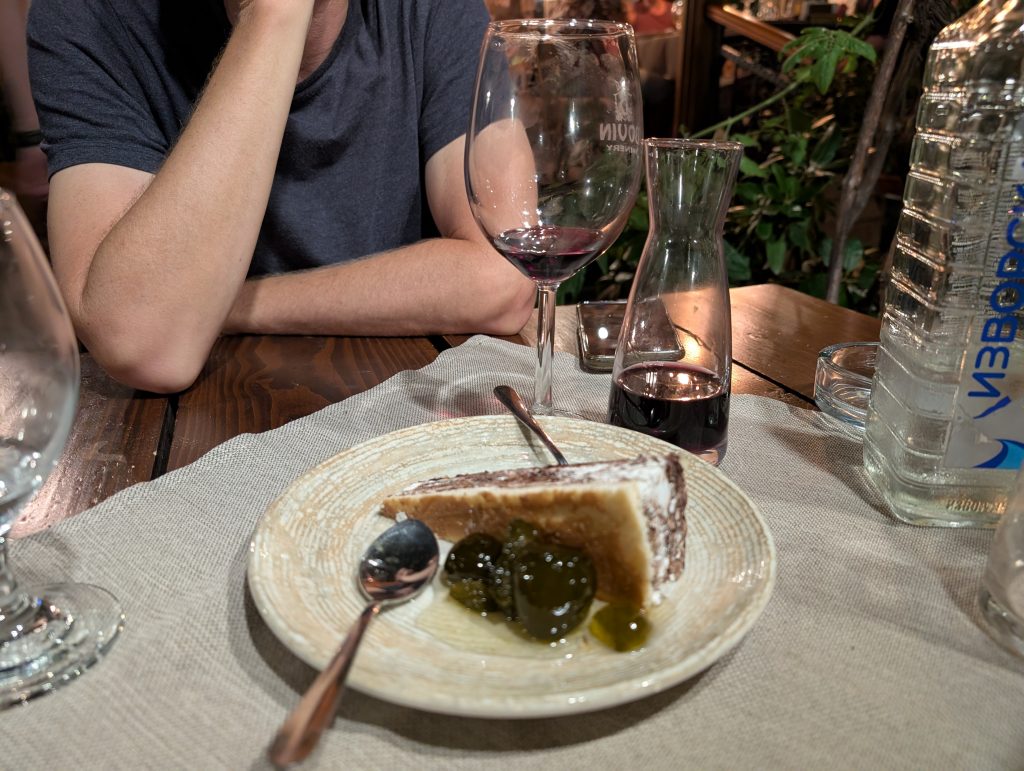
Departure and Summary
The next day we left our Airbnb an hour early for our 8 a.m. bus, because I wasn’t too sure about finding a taxi that early in the morning and am always anxious on travel days. We did find a taxi across from the bakery at the taxi stand our first day driver had pointed out and though it took a little negotiating, paid the same 400 denar price to return as when we arrived. We found a bakery-cafe near the station for coffee and donuts and then boarded our bus to Tirana with no issues.
Our time in Lake Ohrid was definitely a highlight of this leg. It isn’t a place we feel a desire to return to but was very much worth the visit. We could have happily spent a week in Ohrid and spread out our sightseeing a bit more, but the four days we did have were just right.
Ohrid ABB – Good apartment in an absolutely fantastic location. Great communication from Jovan and he met us right on time to let us into the apartment. The view of the lake from the bedroom/balcony is very special. We loved sitting on the little balcony in the late afternoons – great shade that time of day. The apartment is generally comfortable, though as other reviews noted, the bathroom could use an update. However, it was workable with good hot water and I think the older bathroom is why the apartment is such a good value for this location and view! The kitchen was equipped enough for basic cooking, though adding a kettle would be very helpful. Wifi worked well. My husband and I really liked our stay here.
Side Note
I’d read on the blog I mentioned earlier about the prevalence of older cars in Ohrid. We definitely noticed that too and took several photos.
